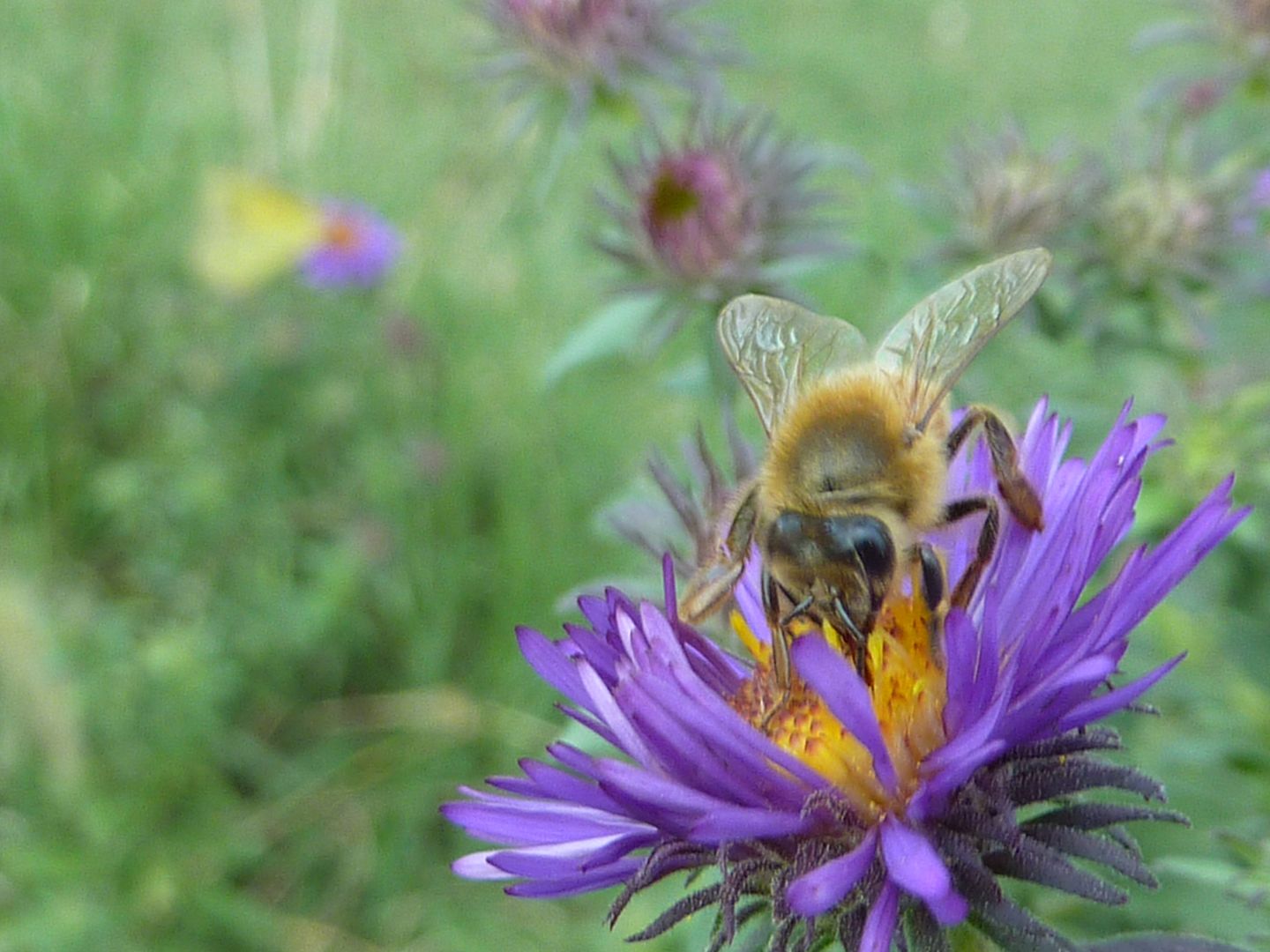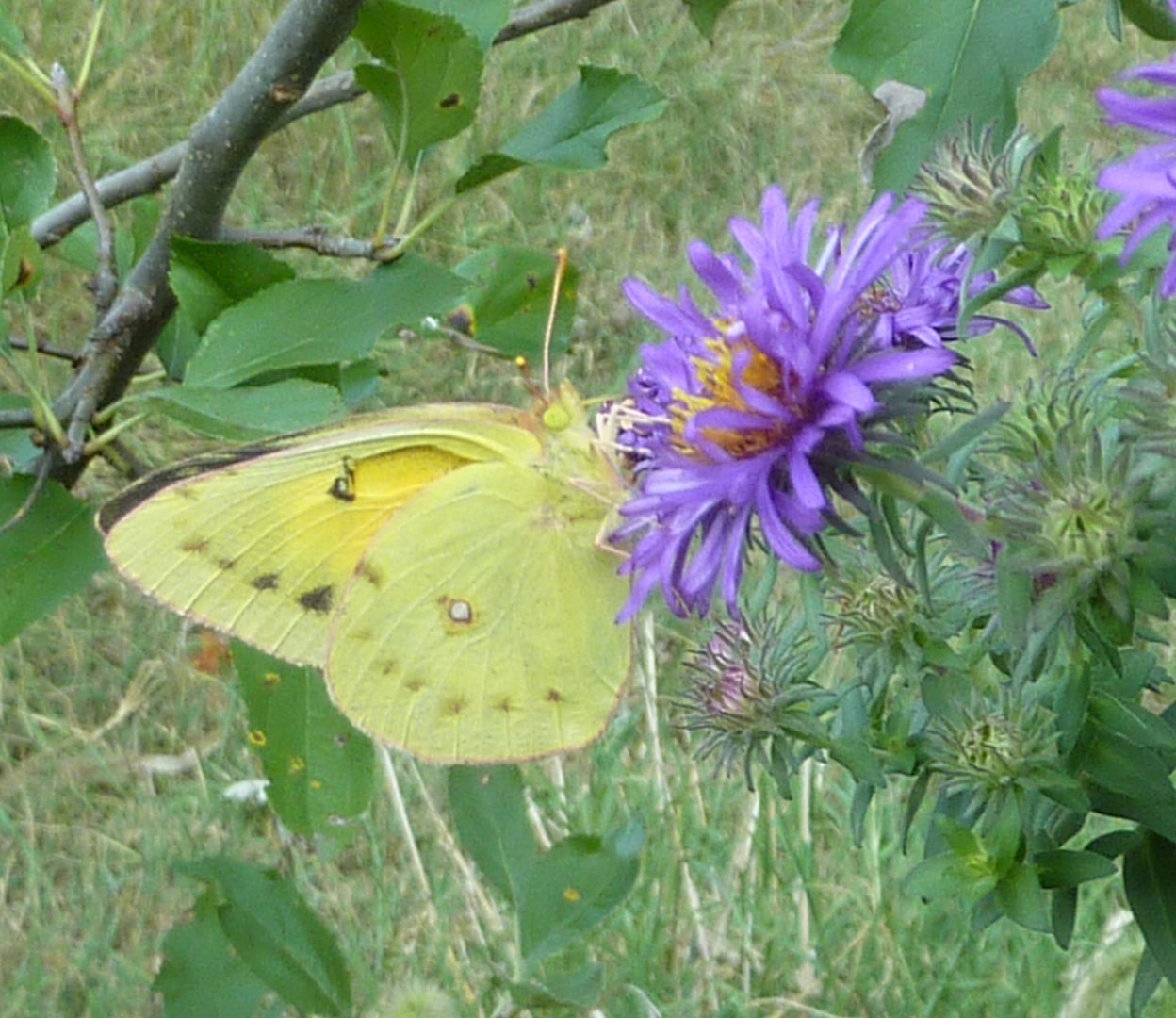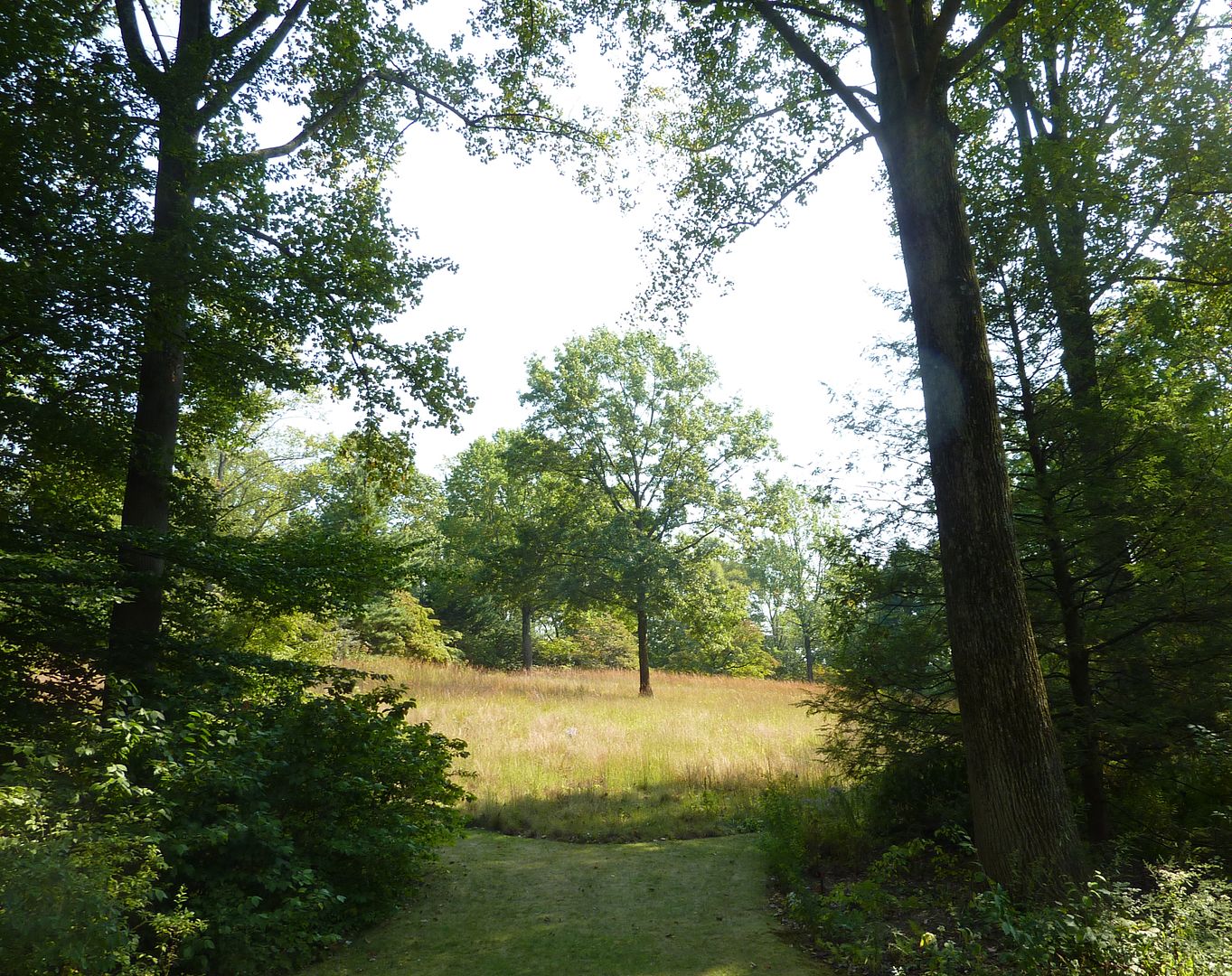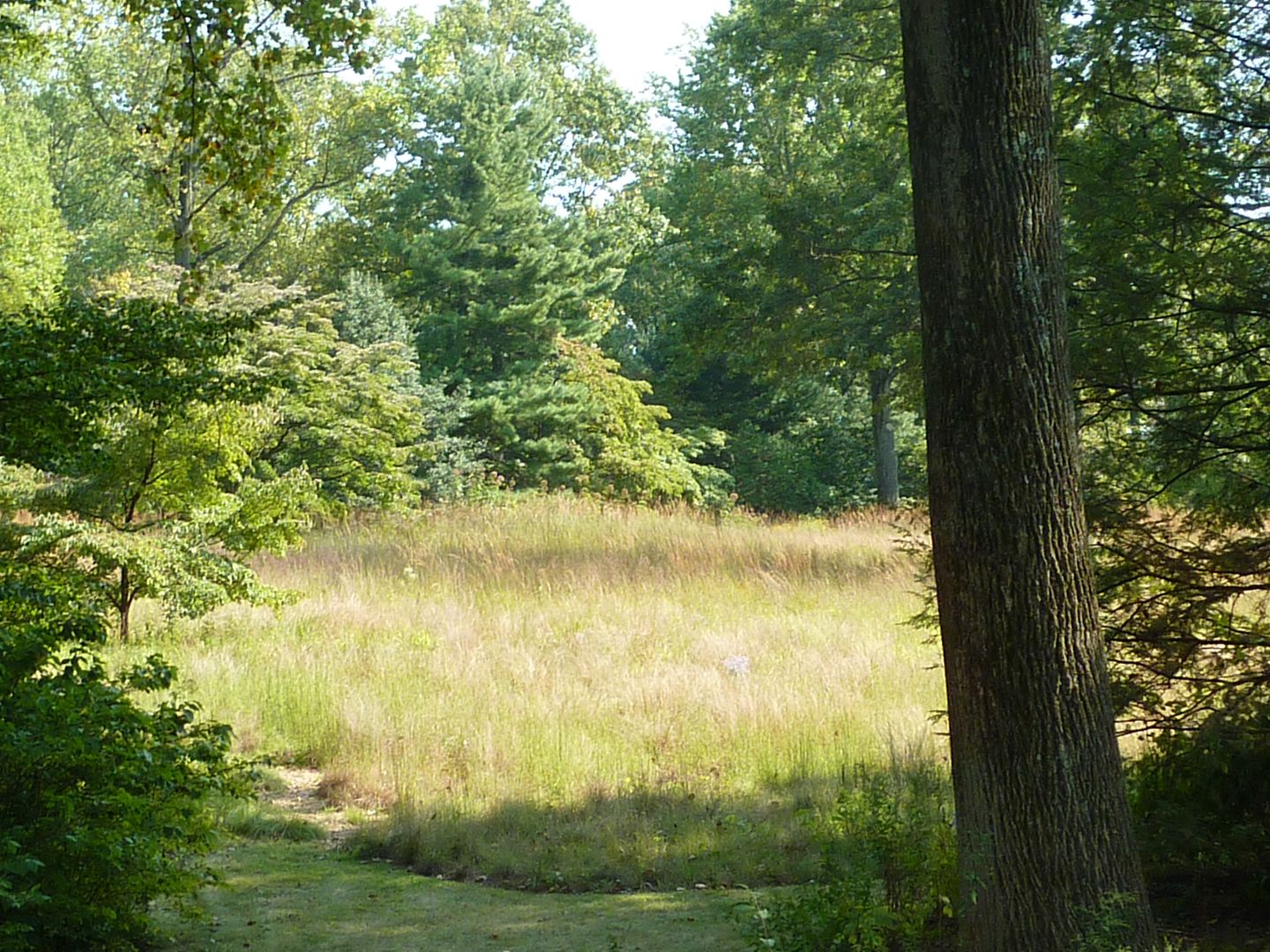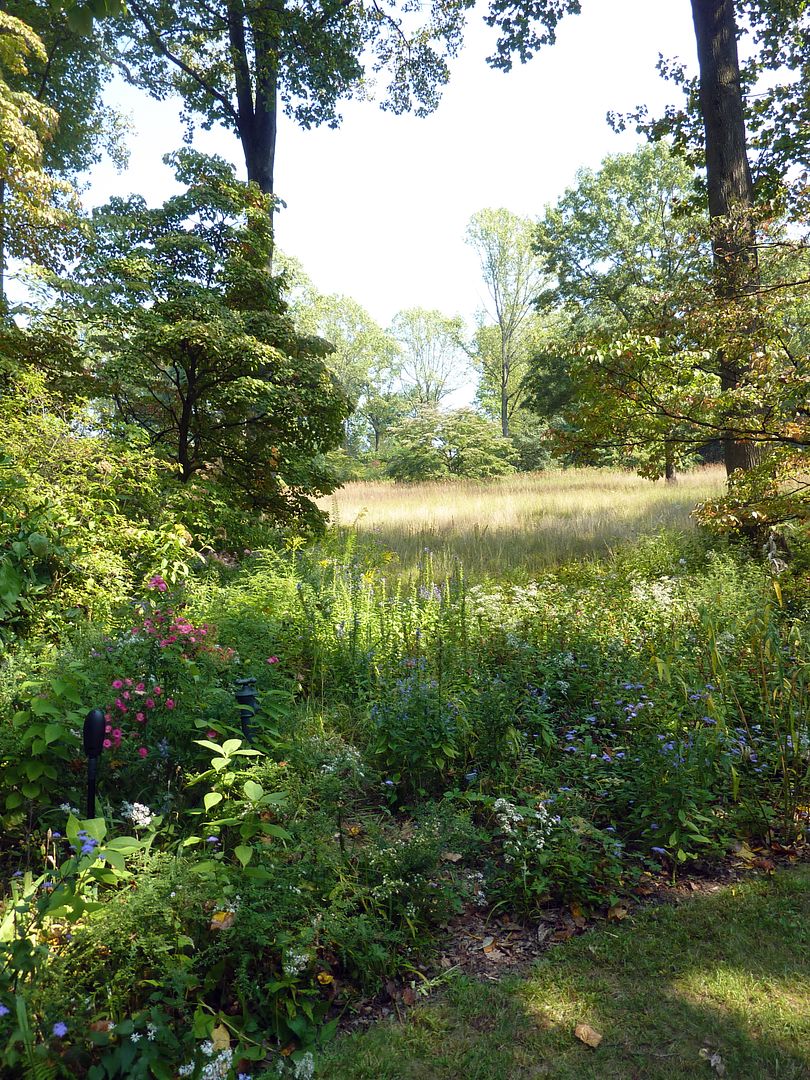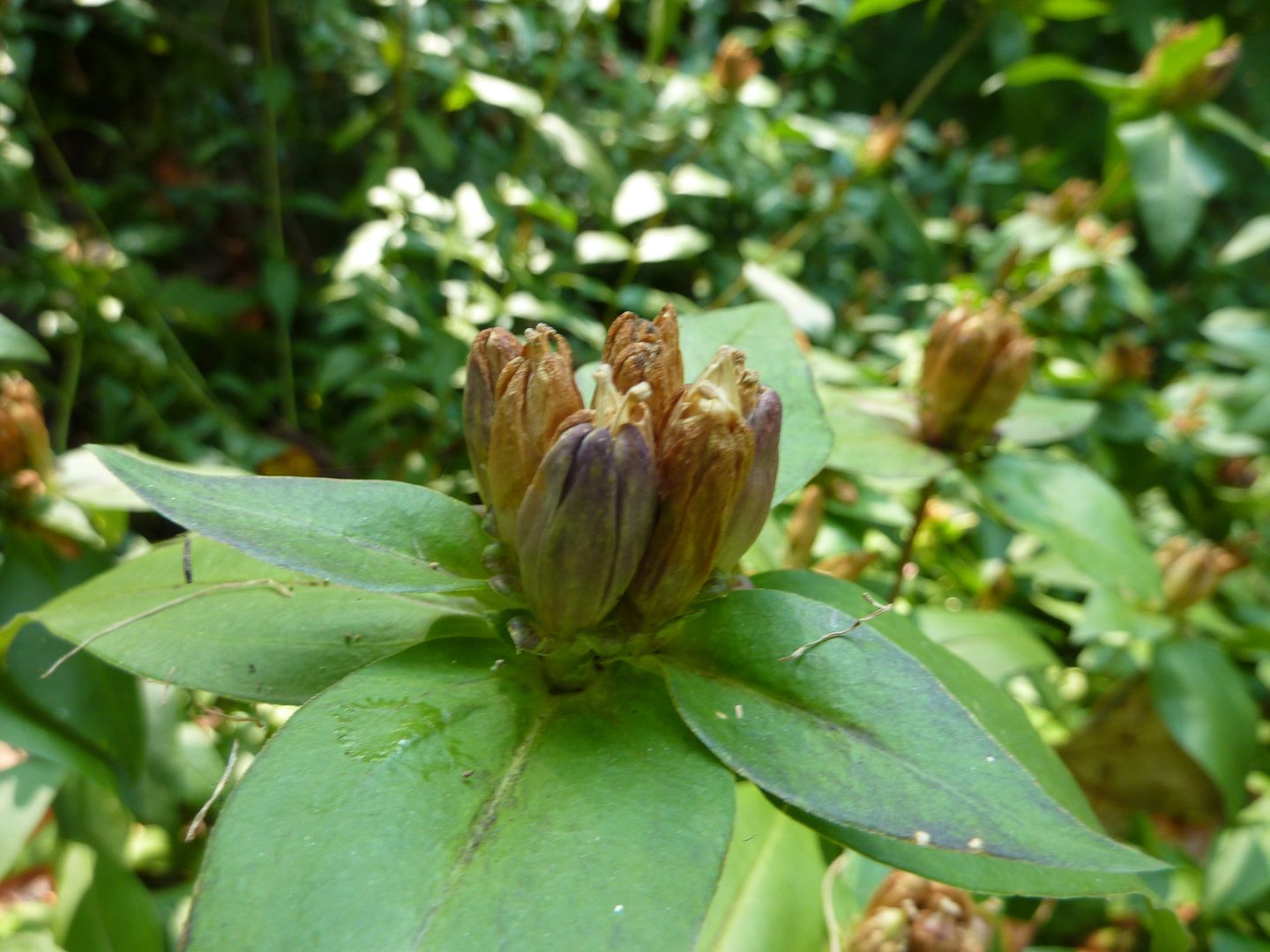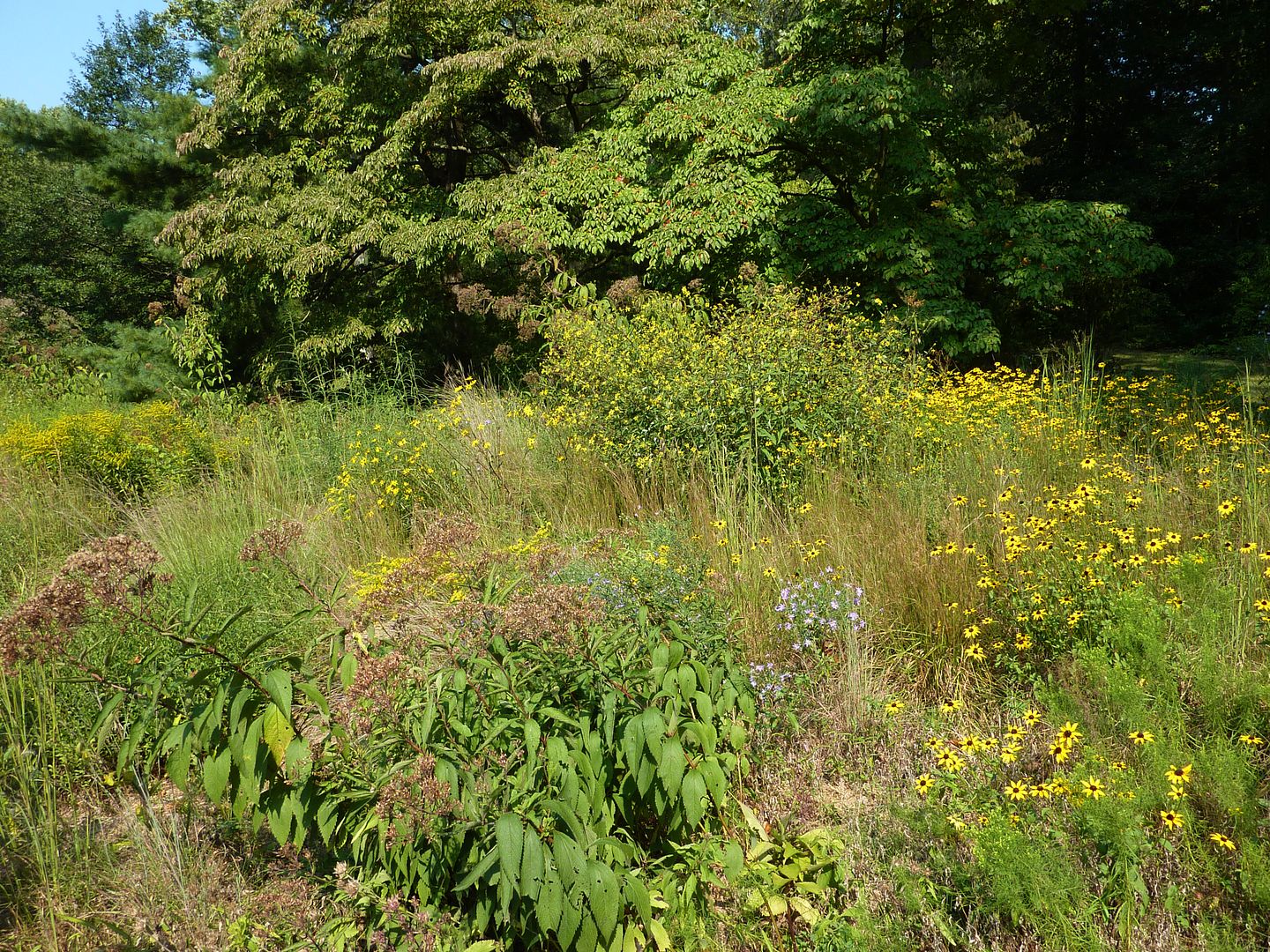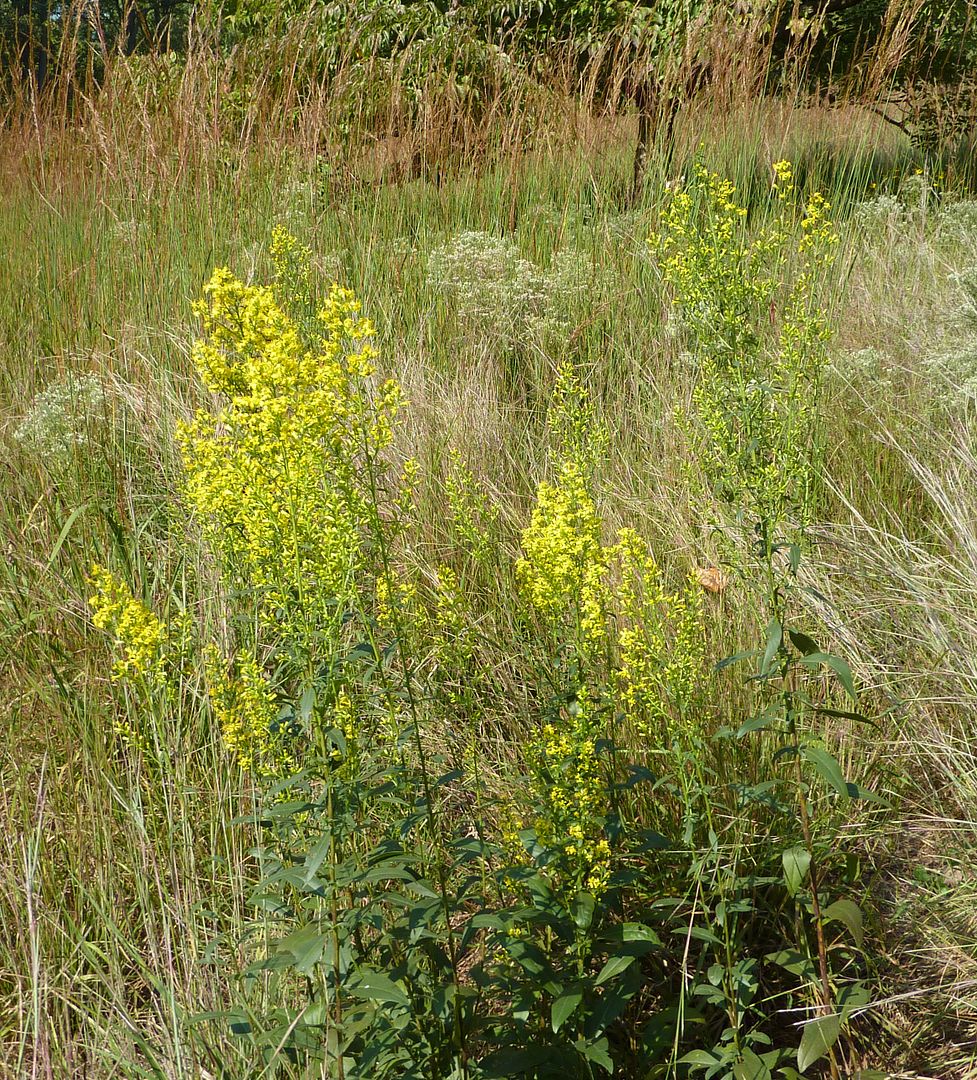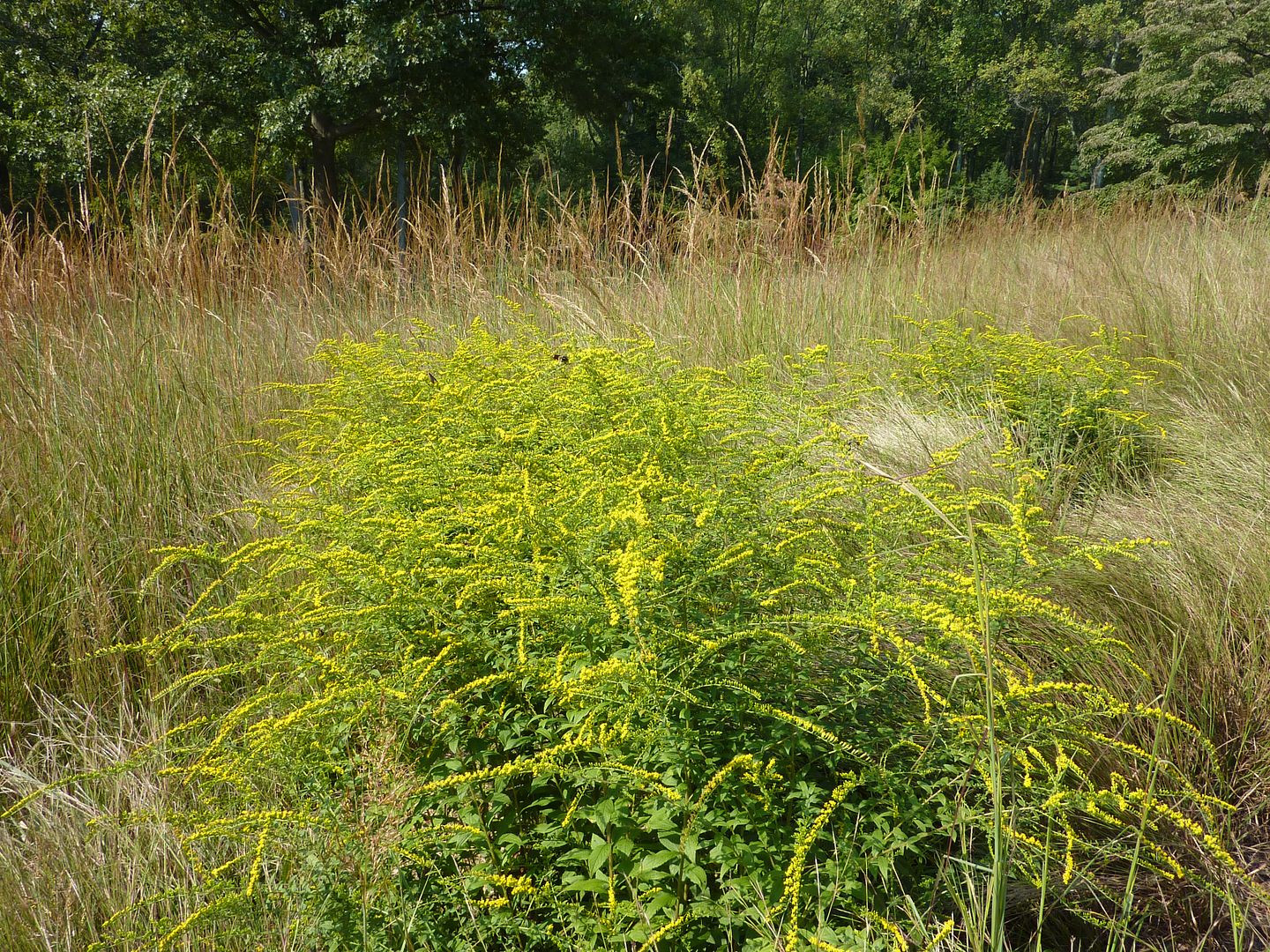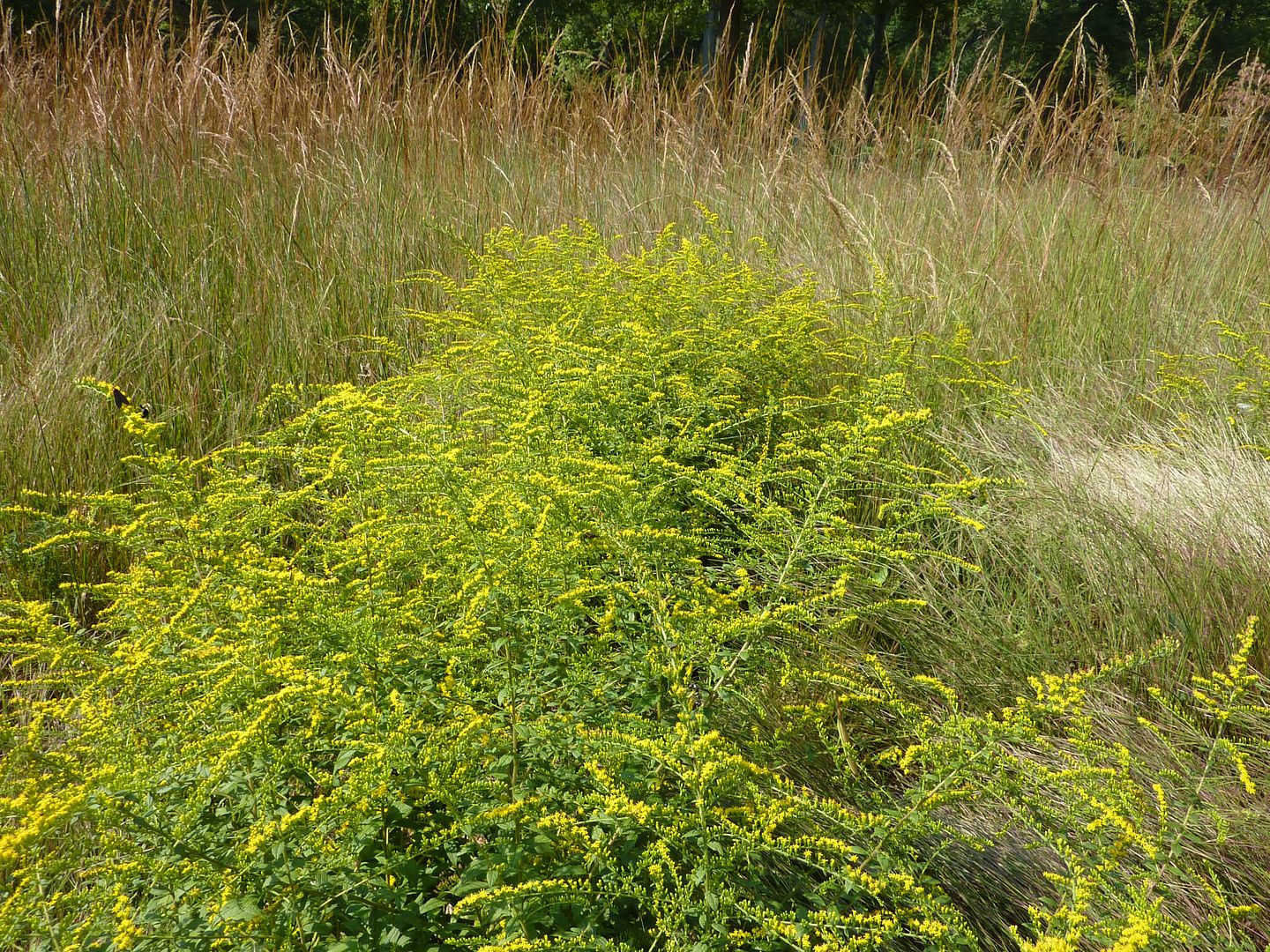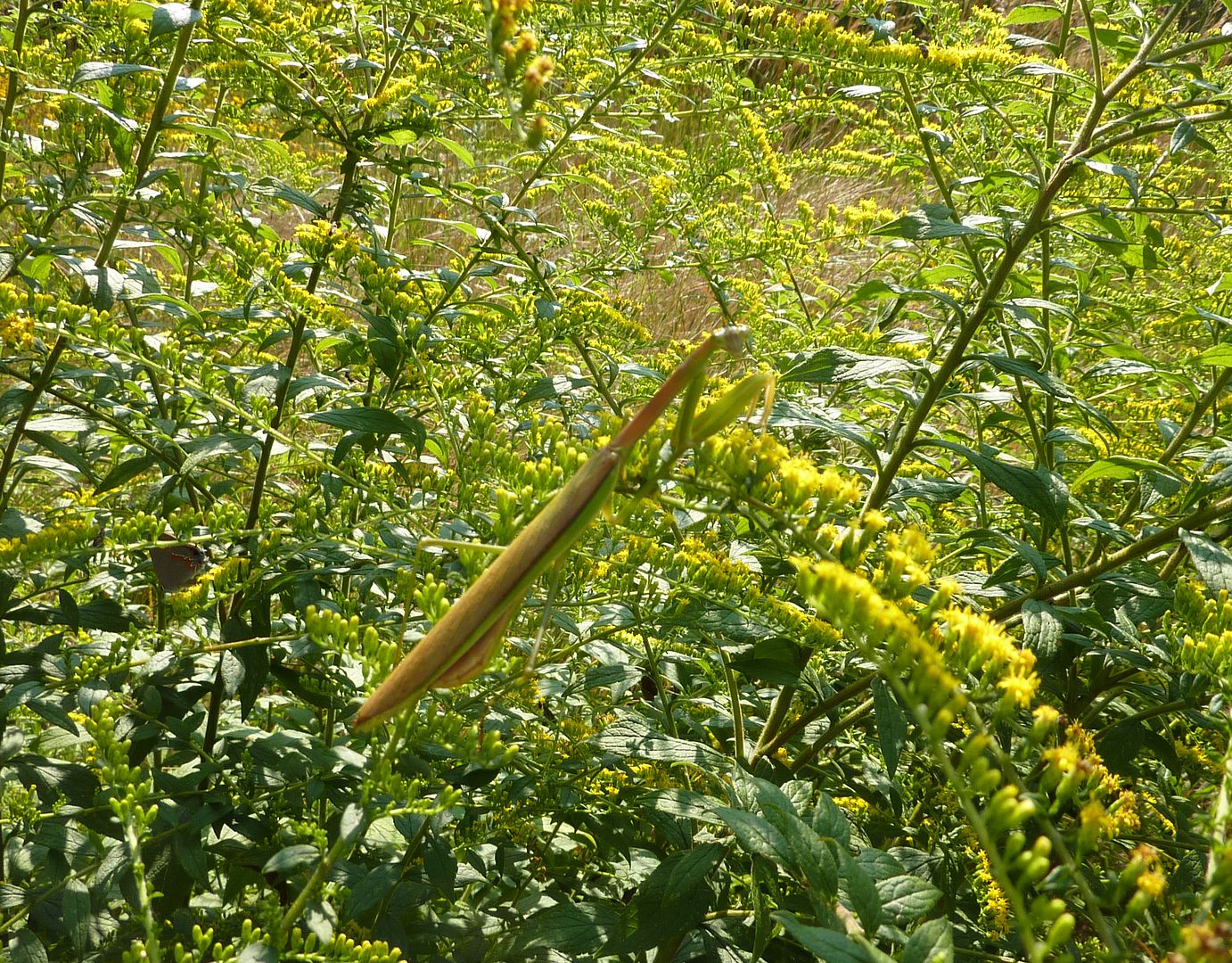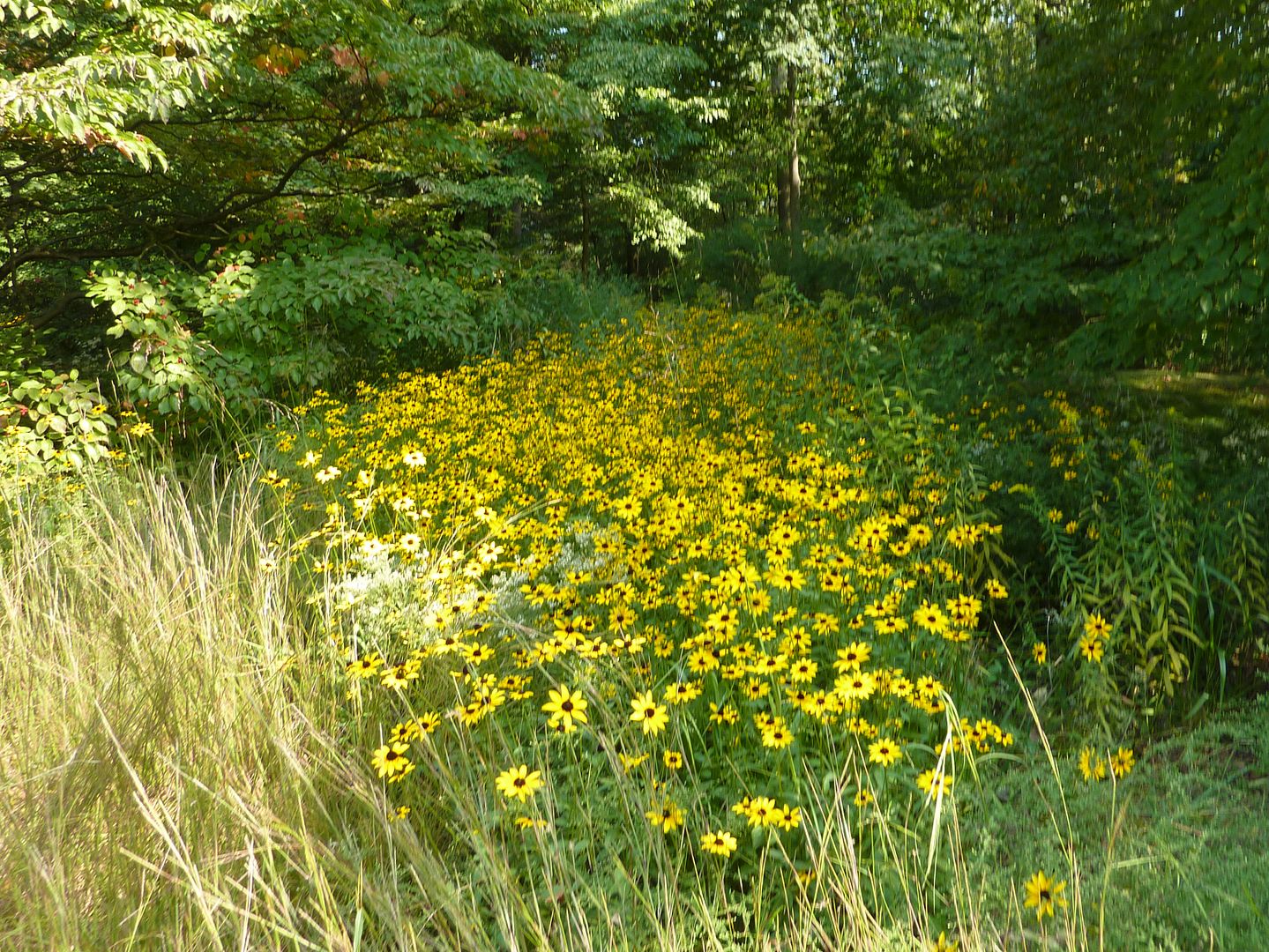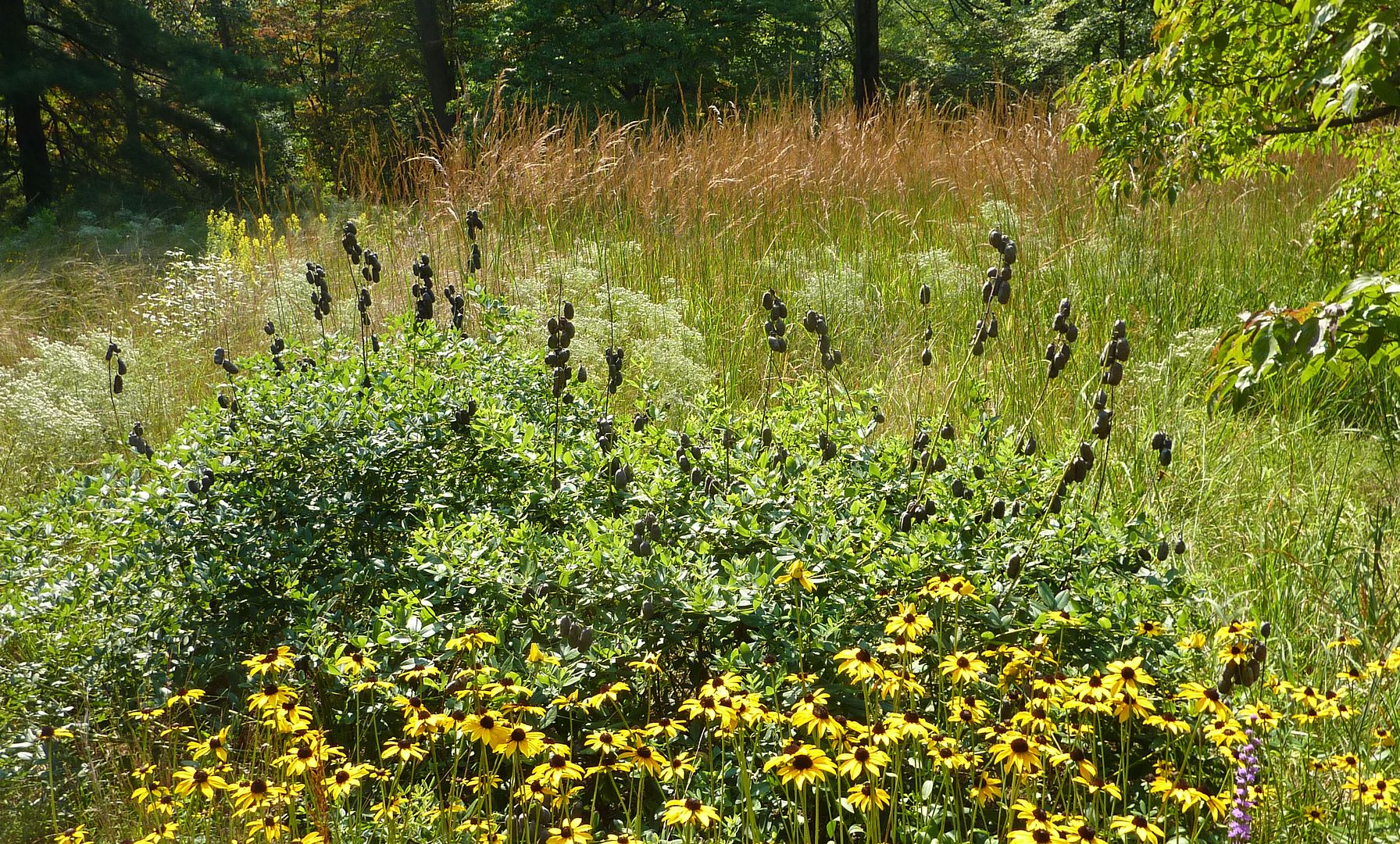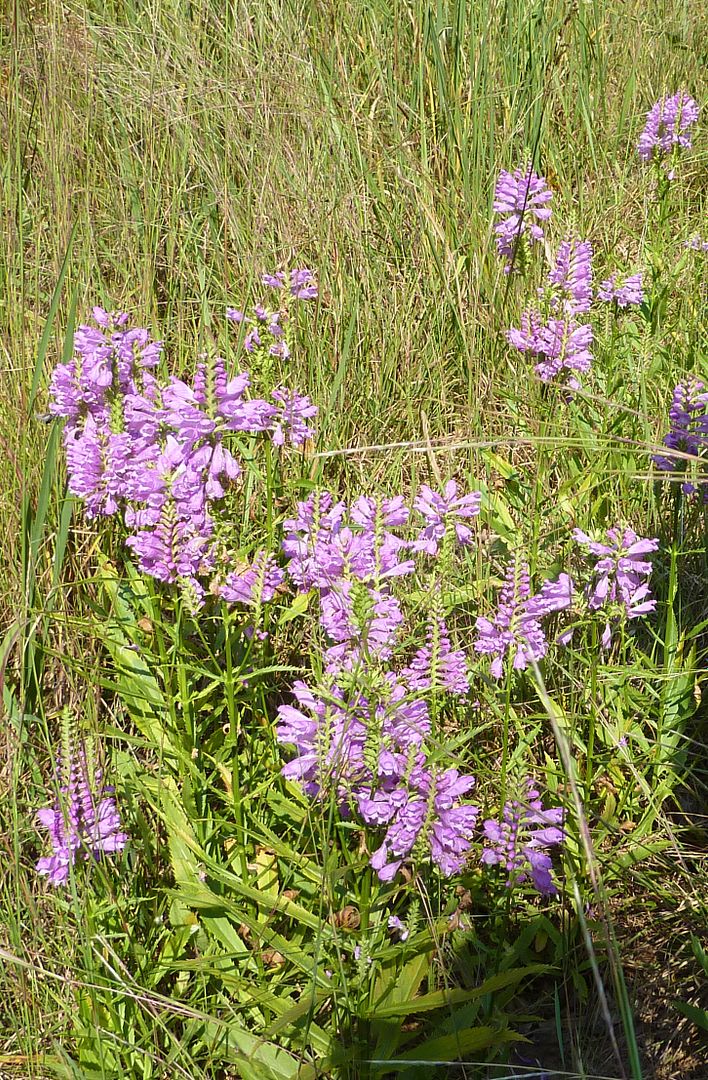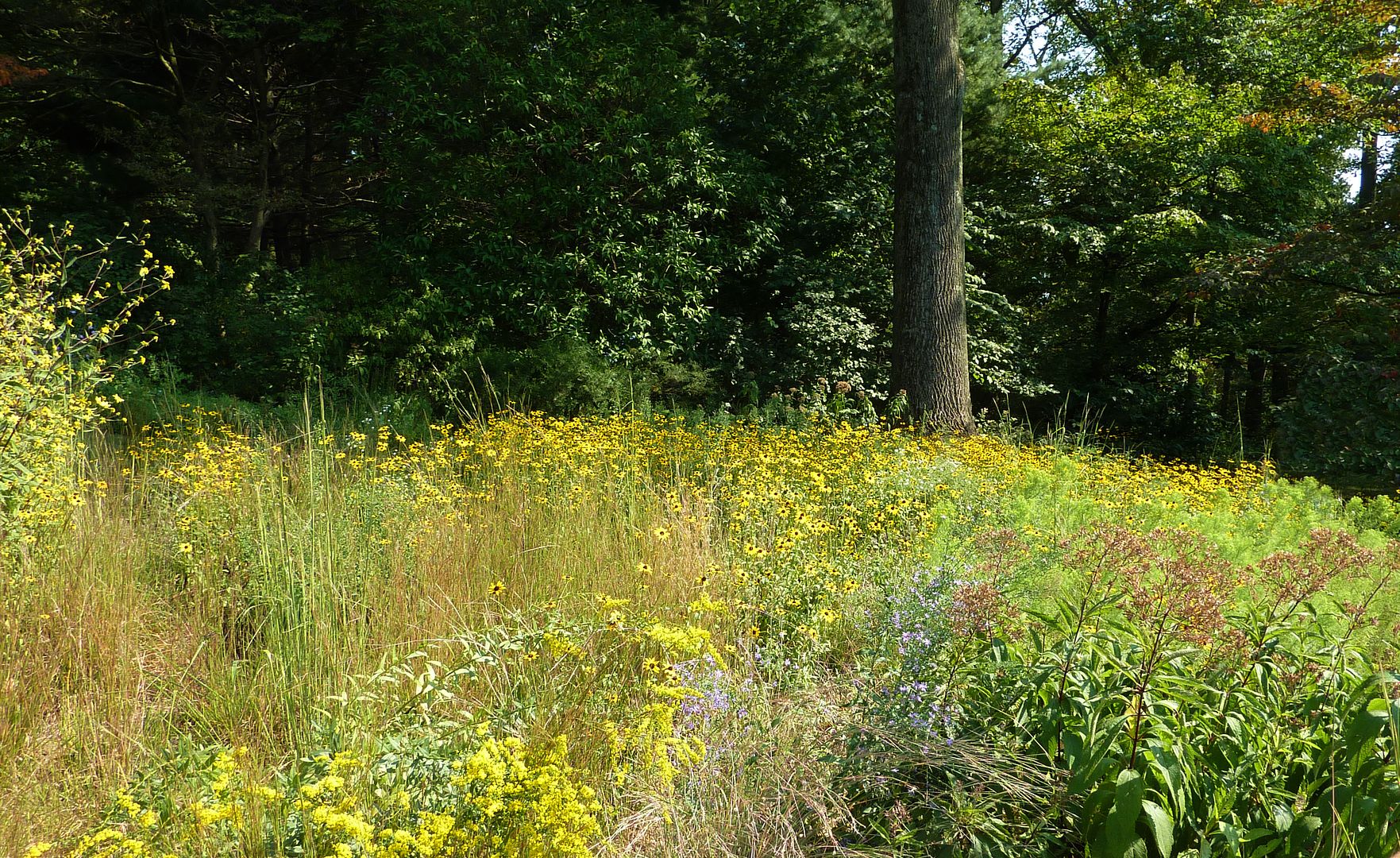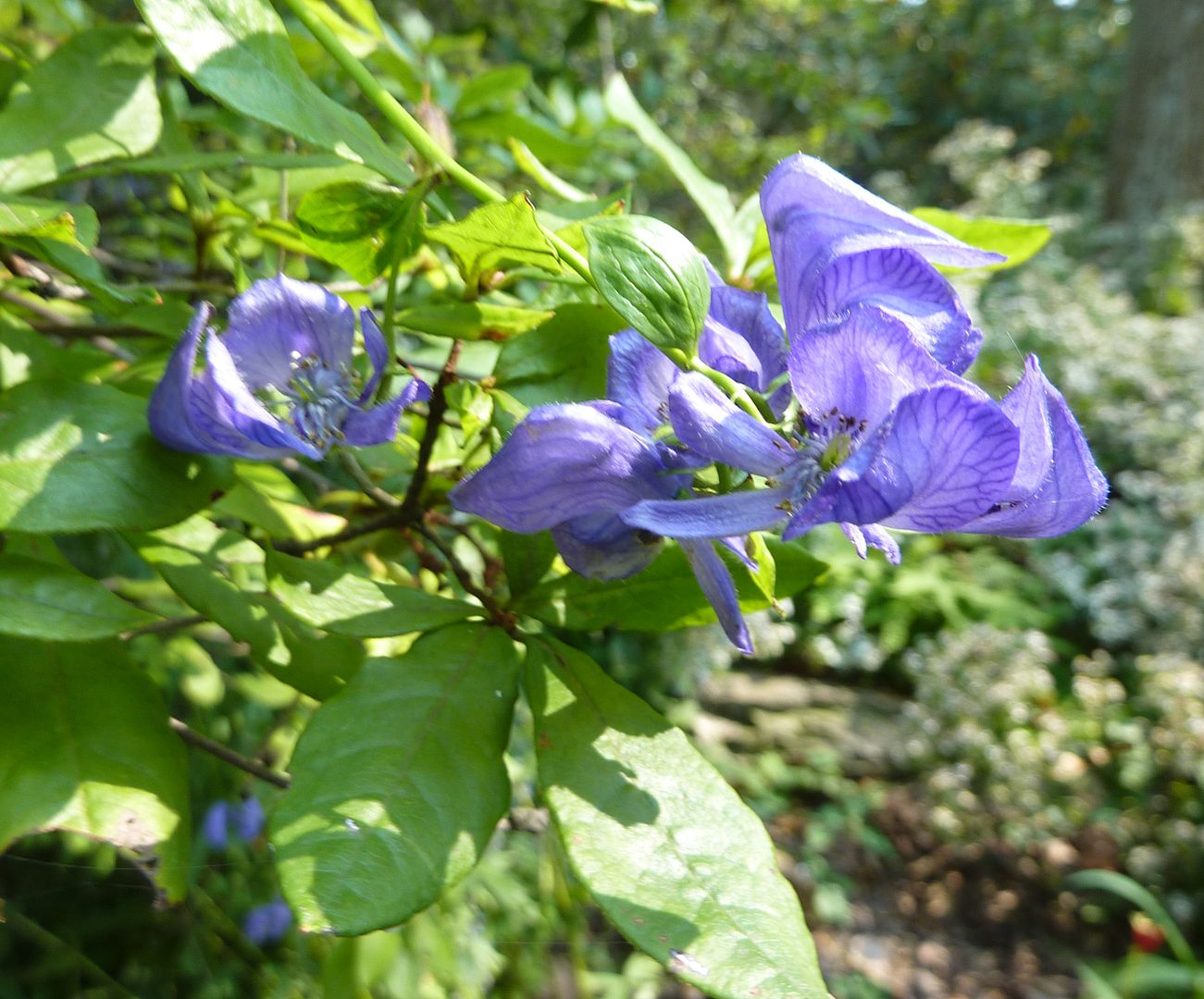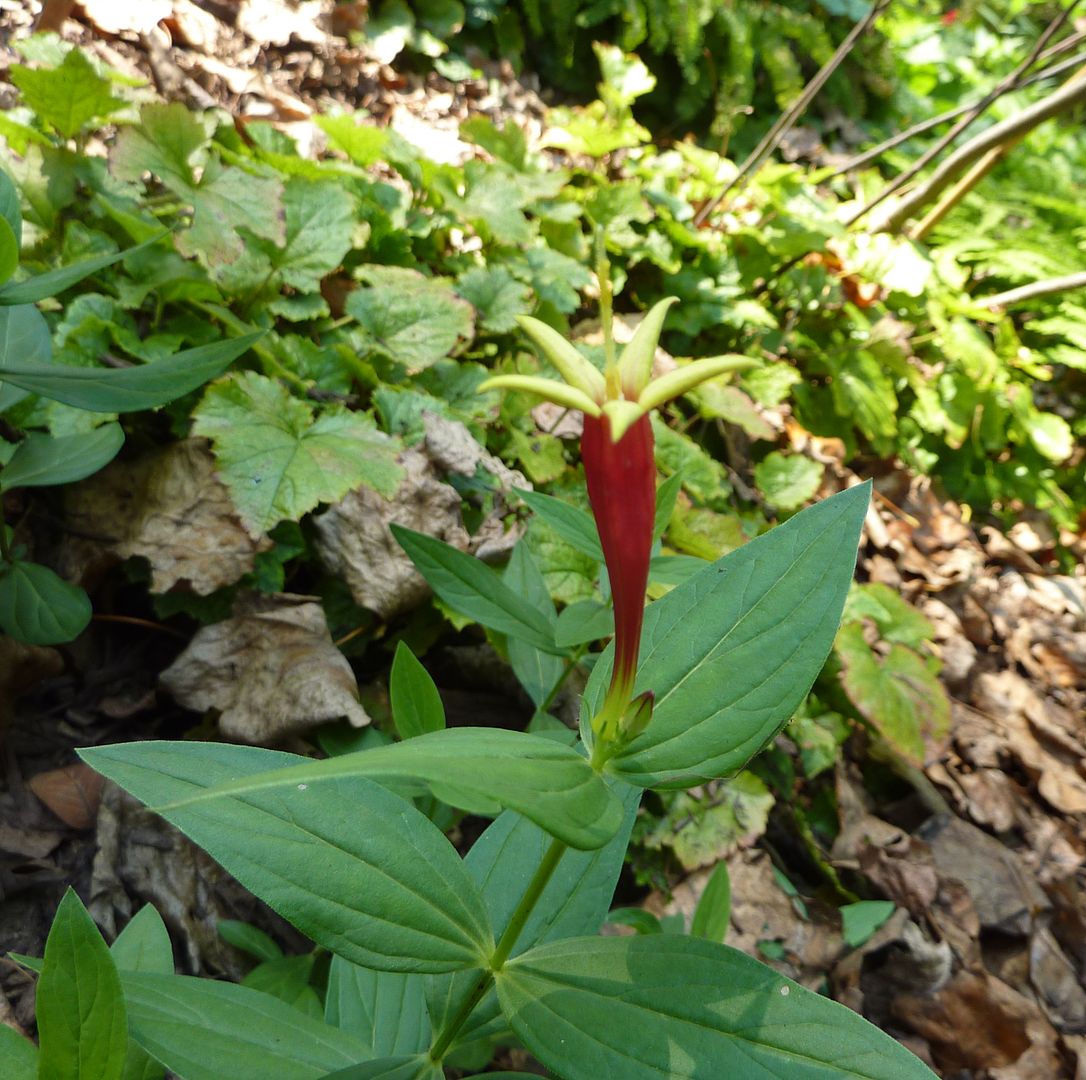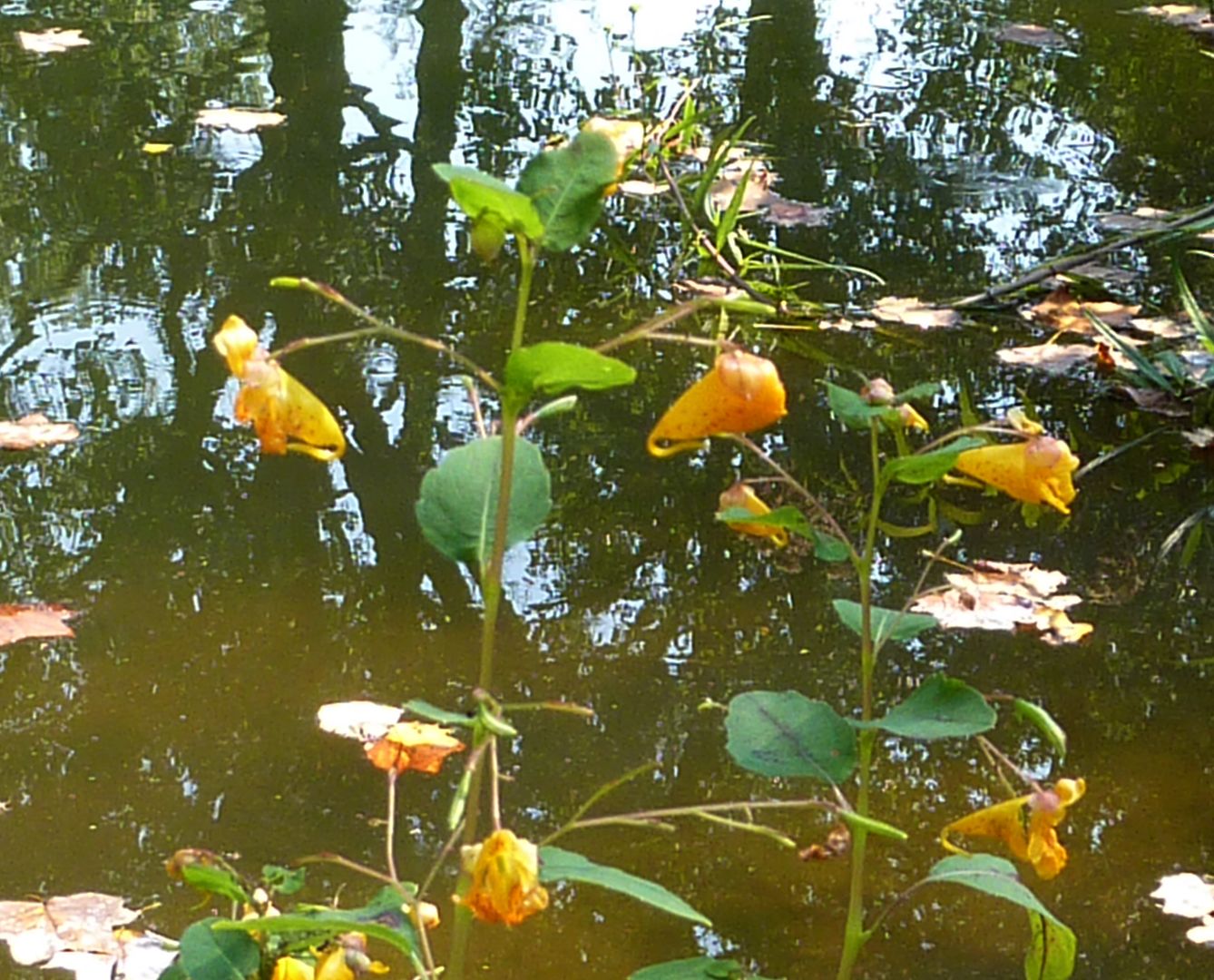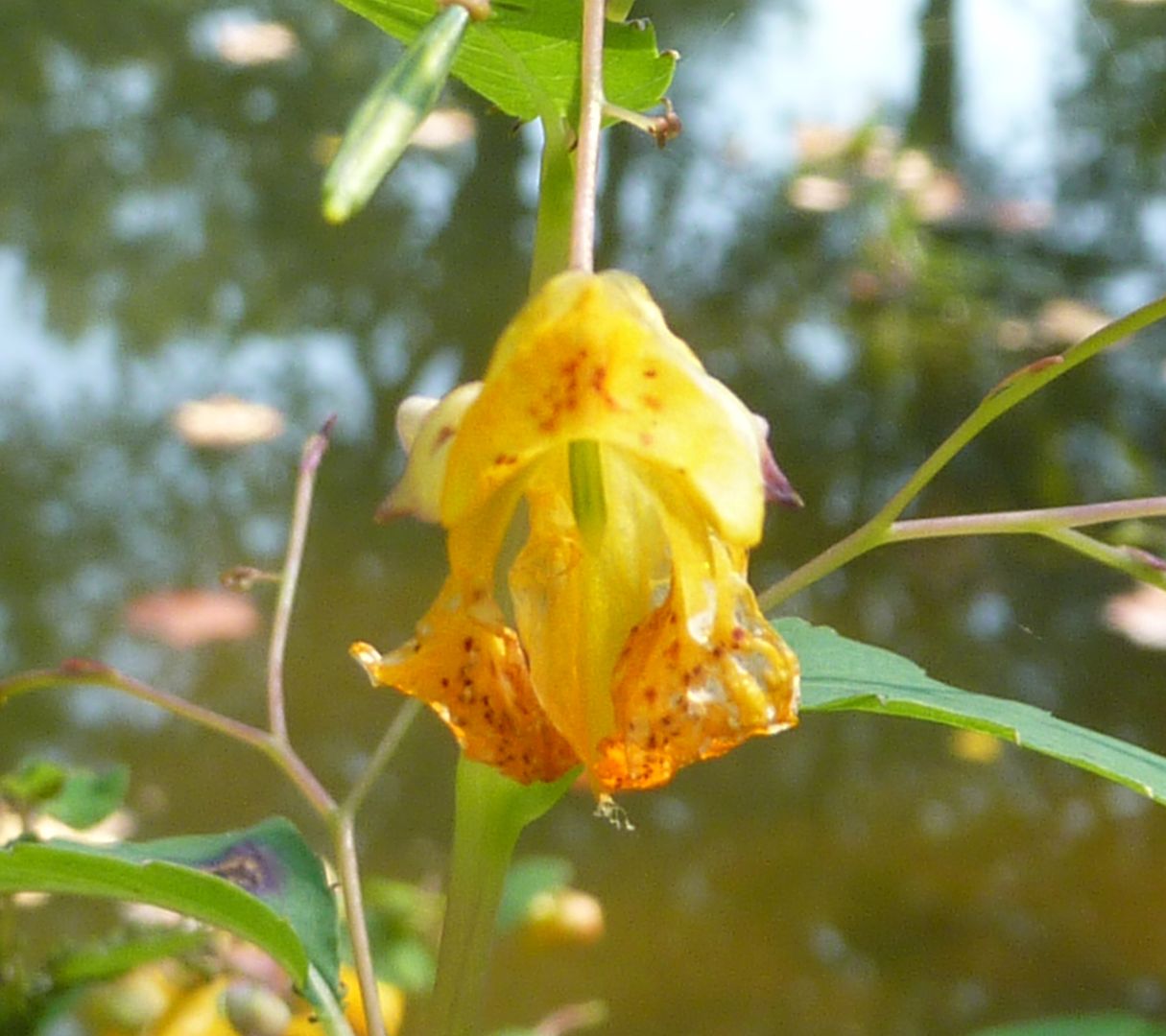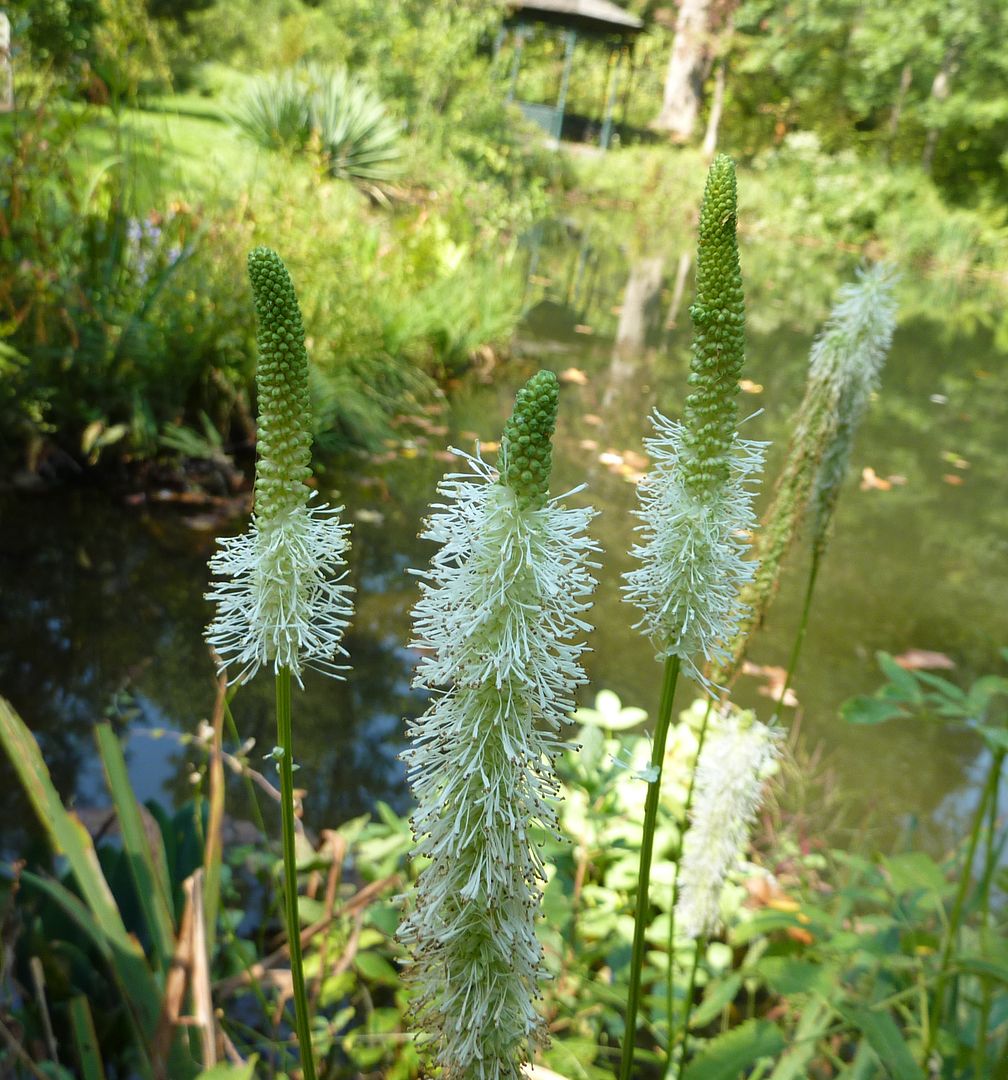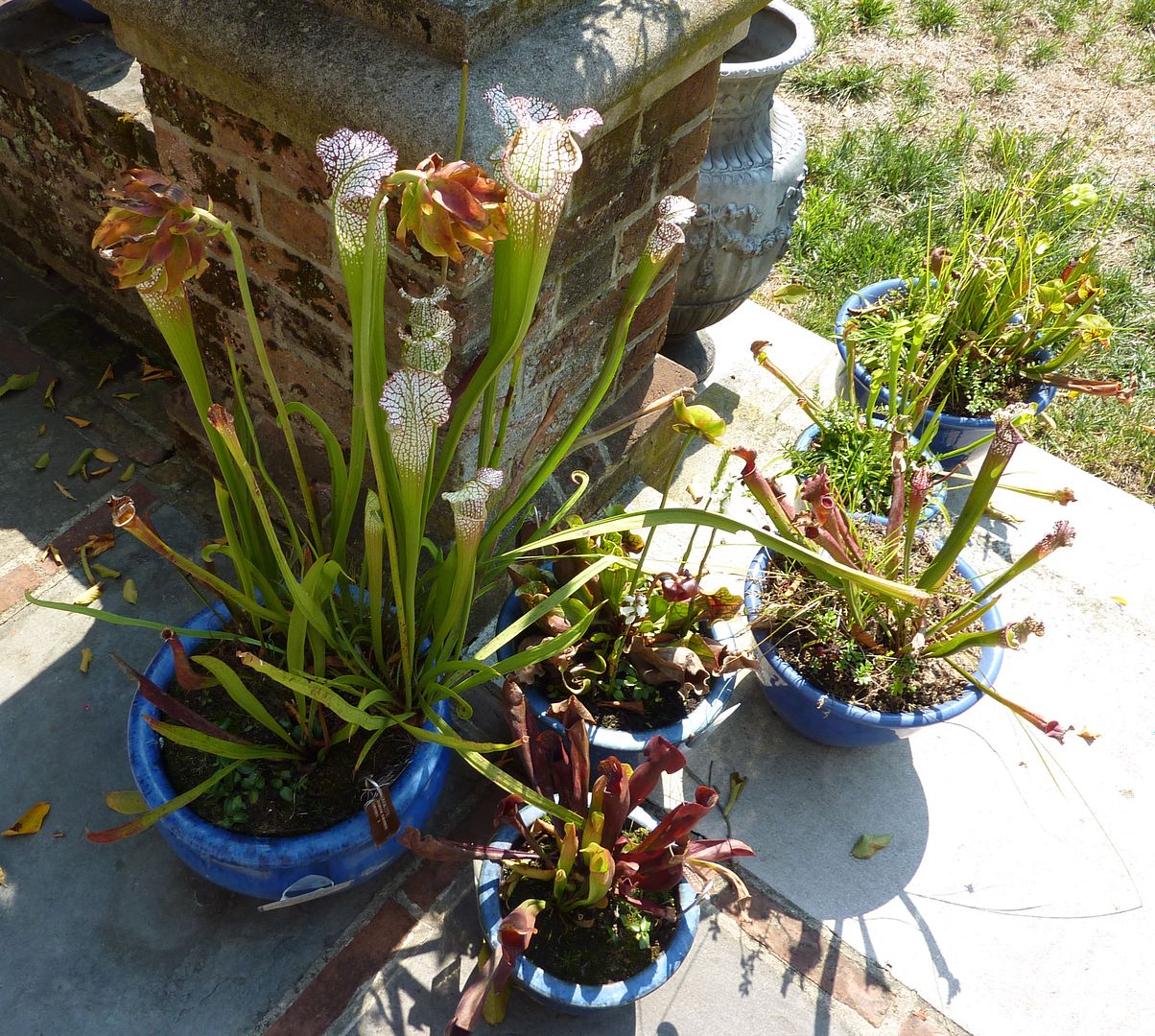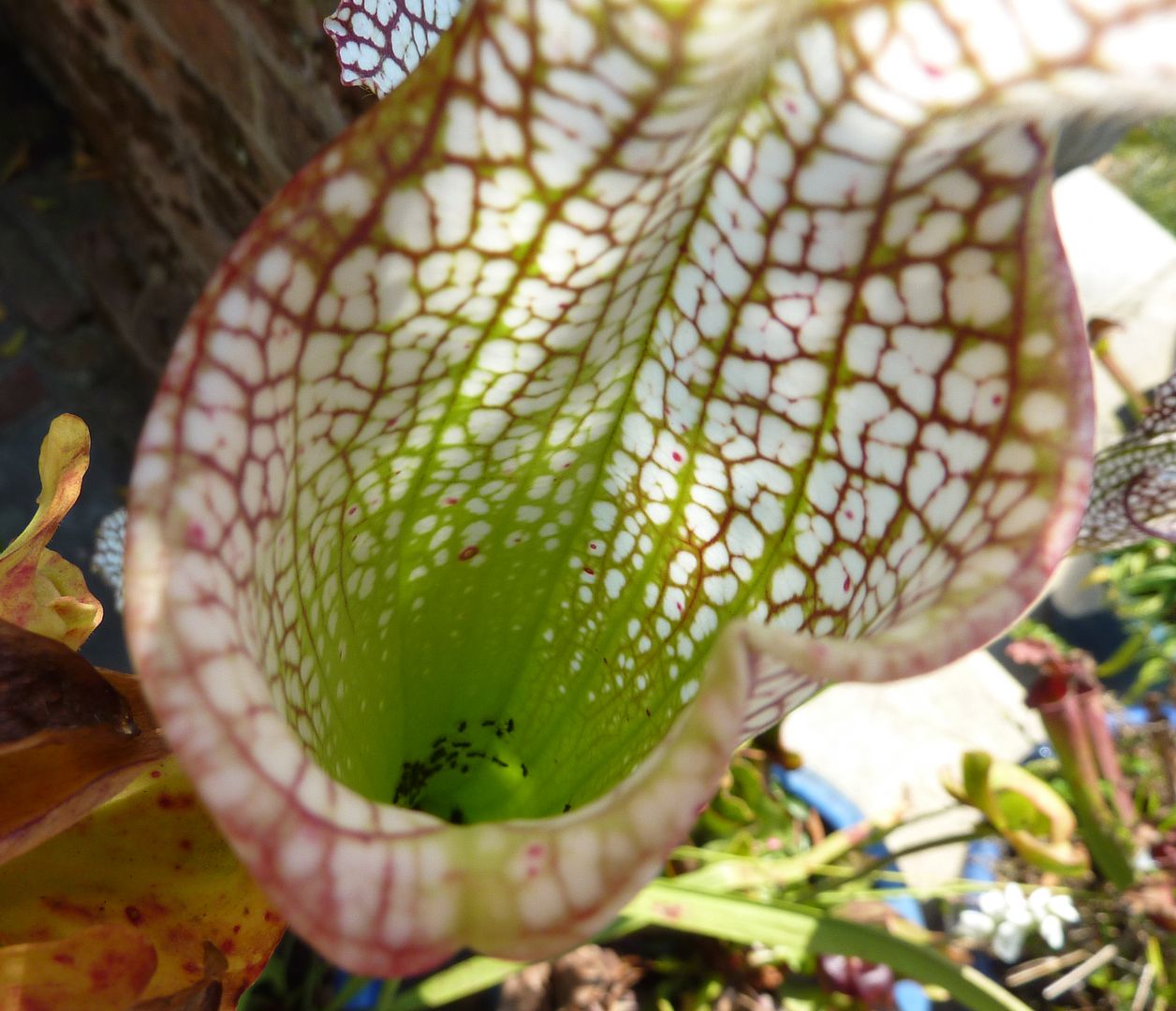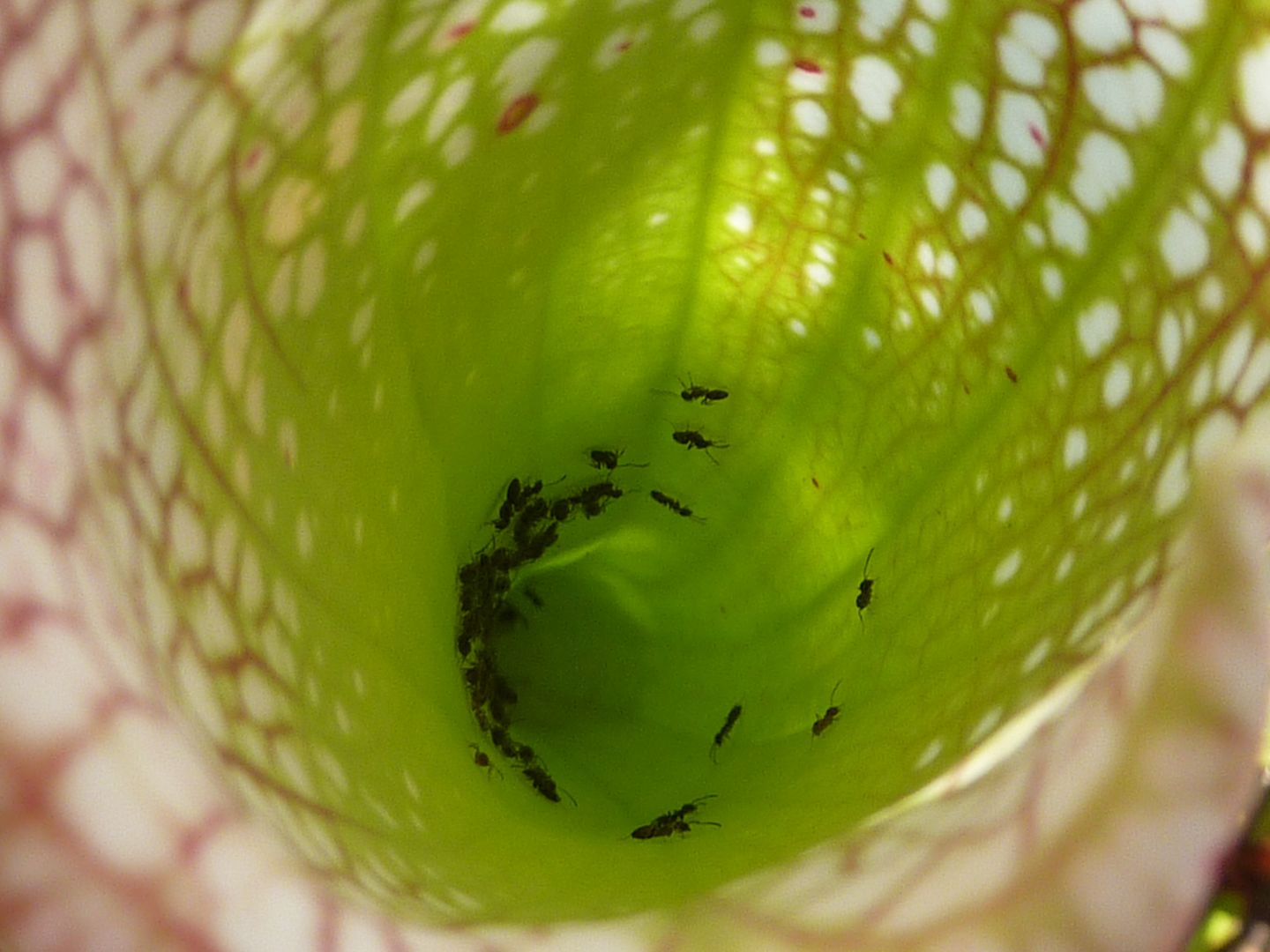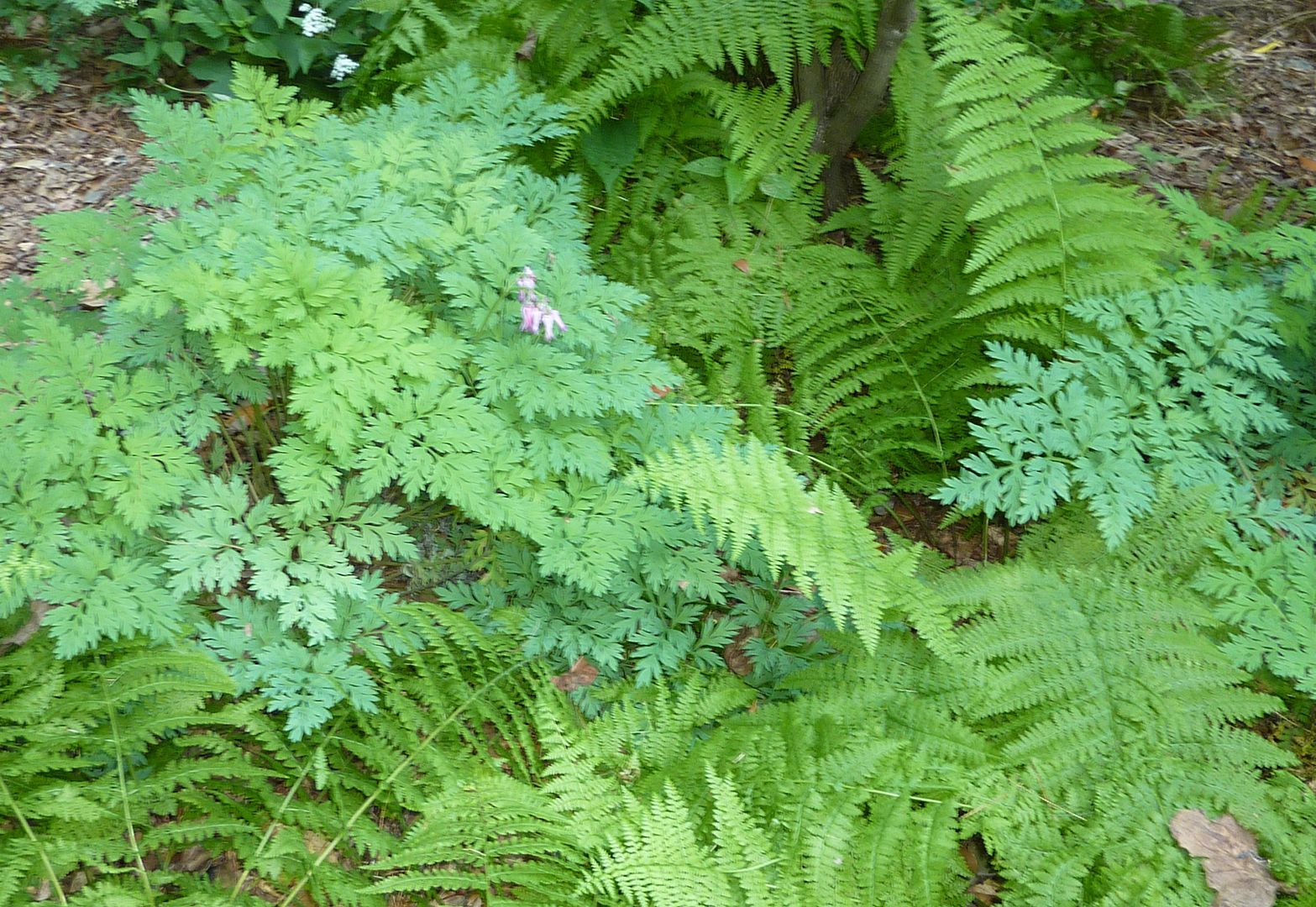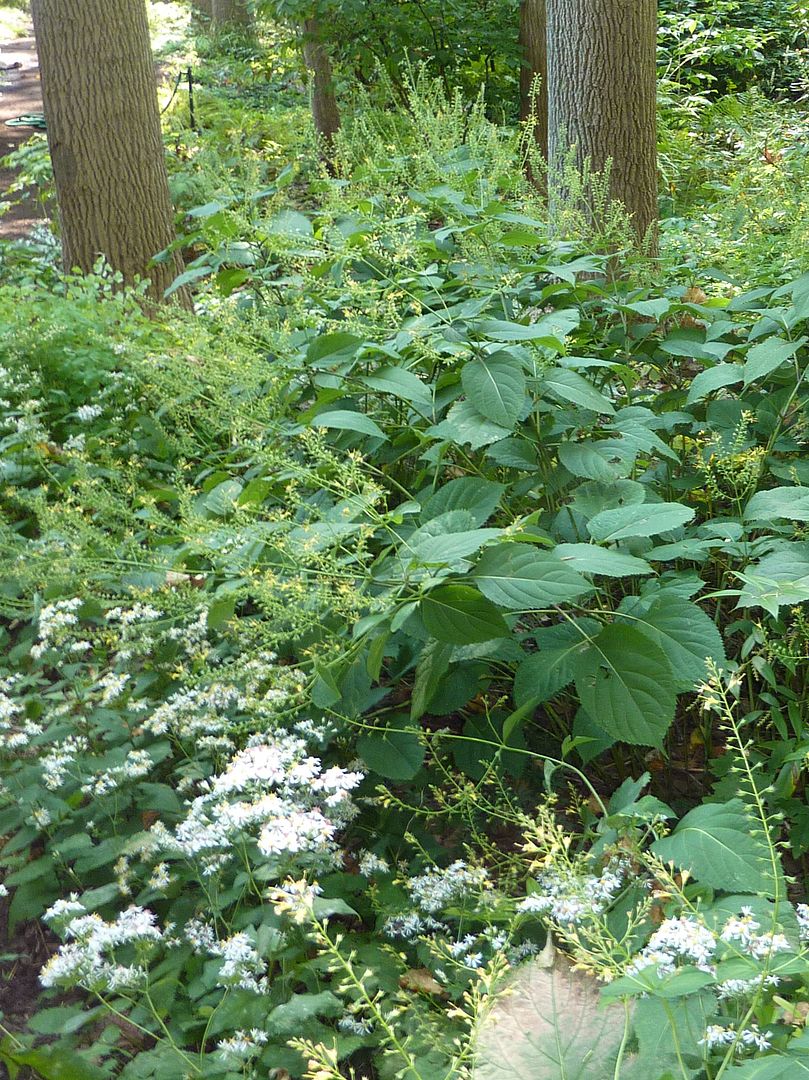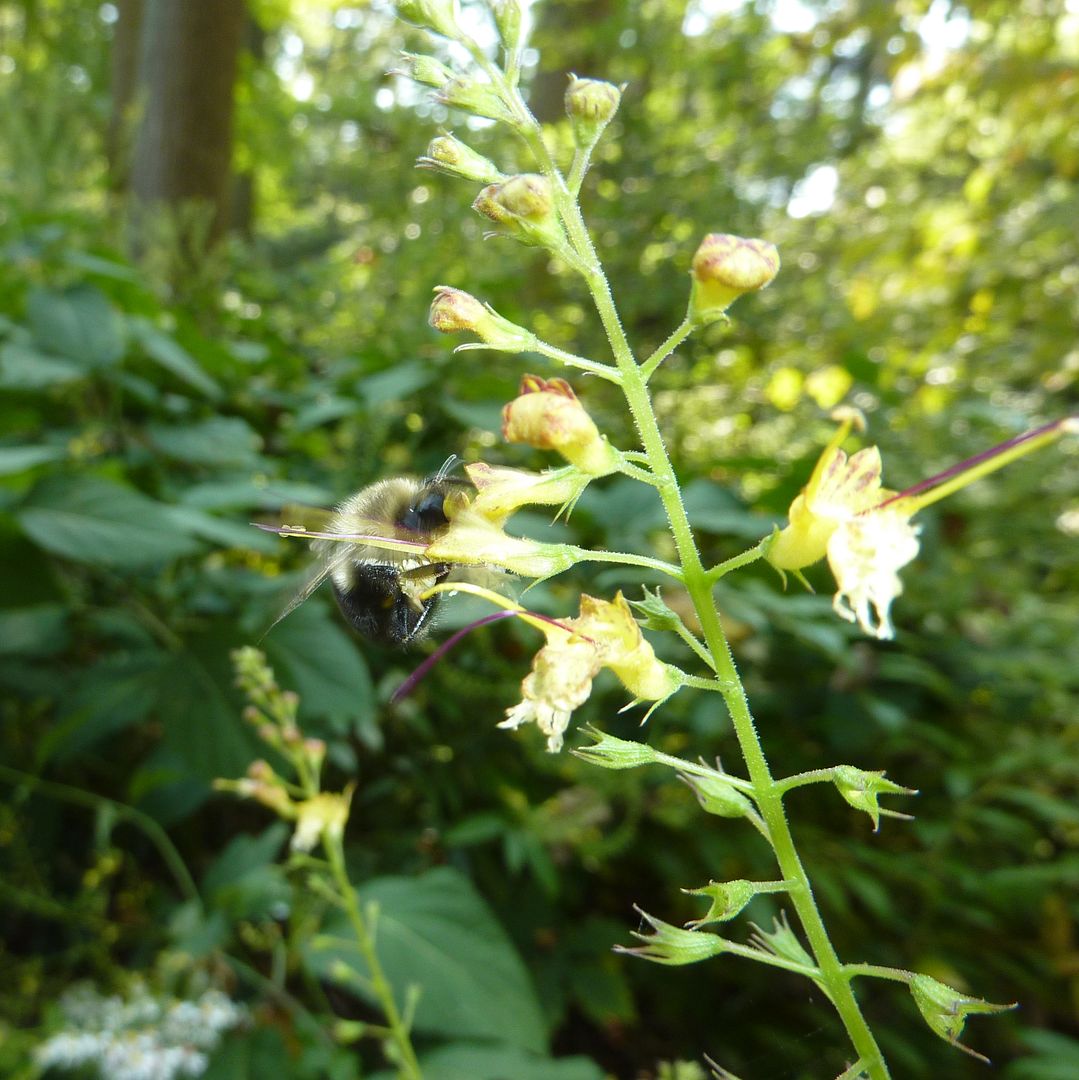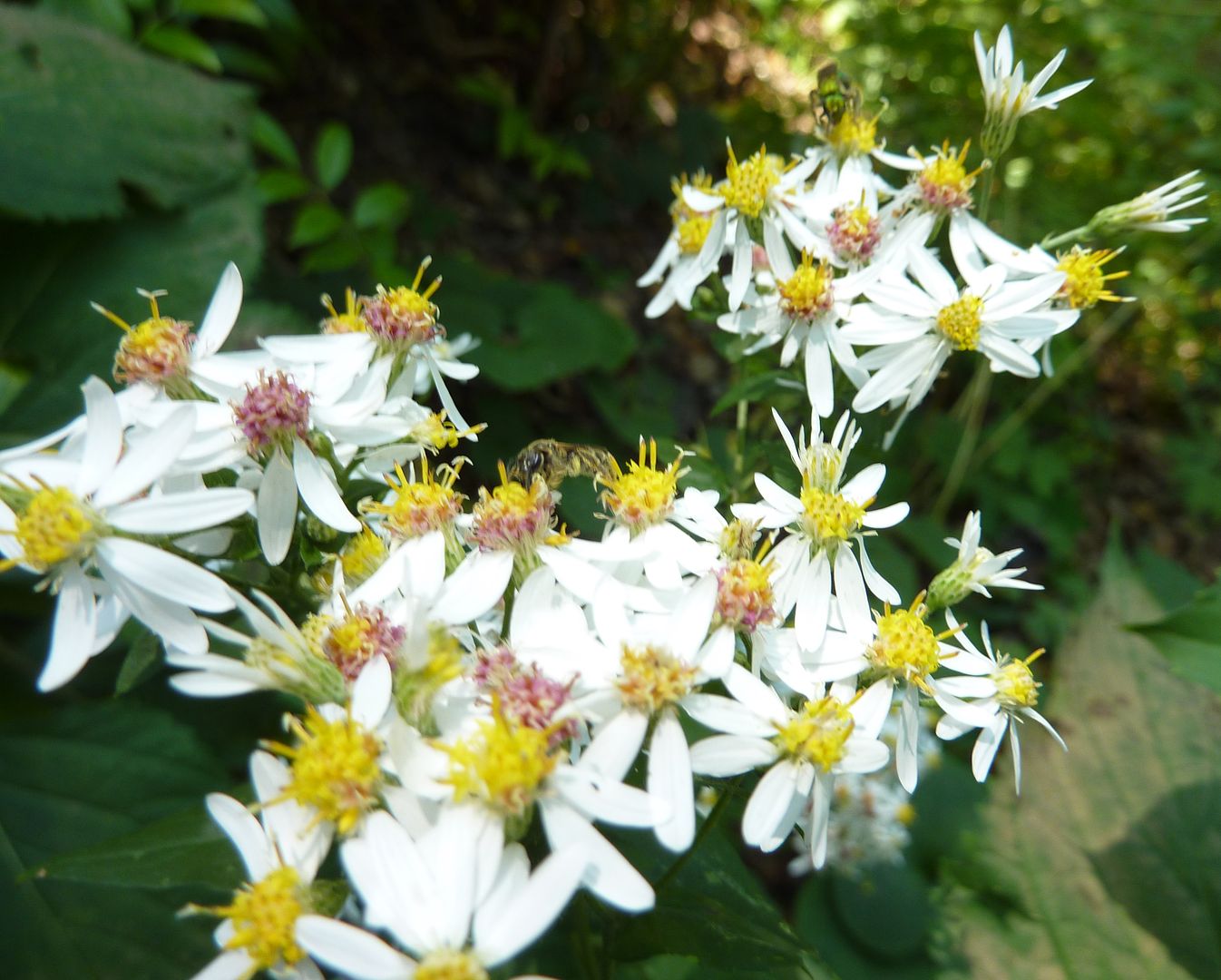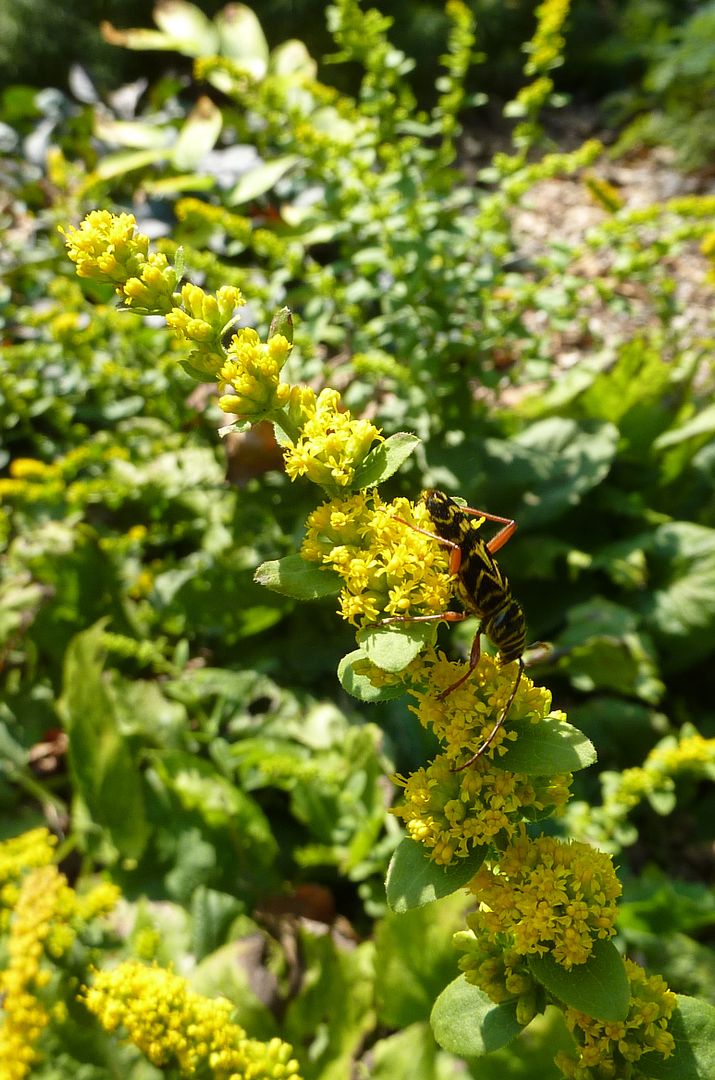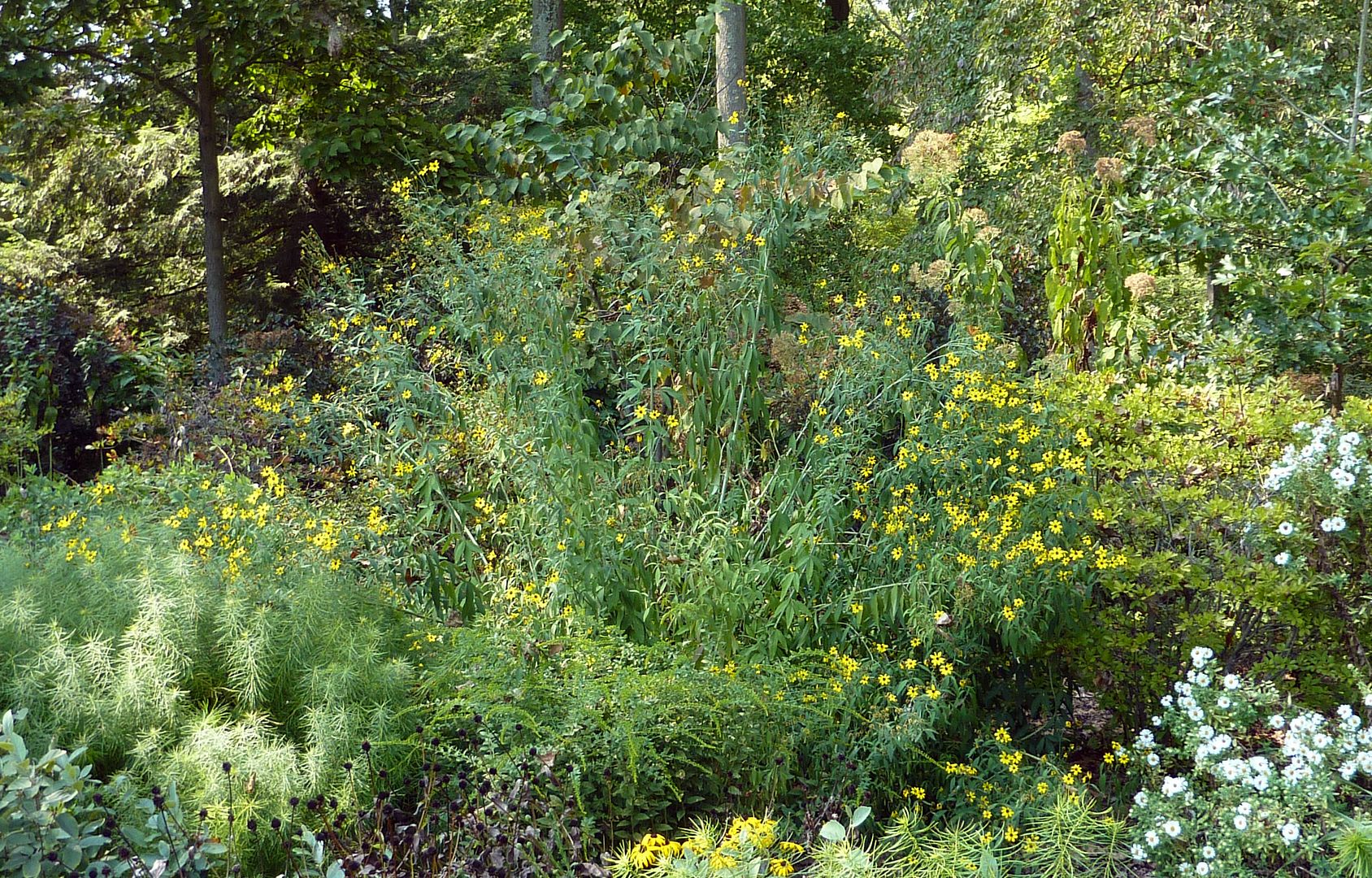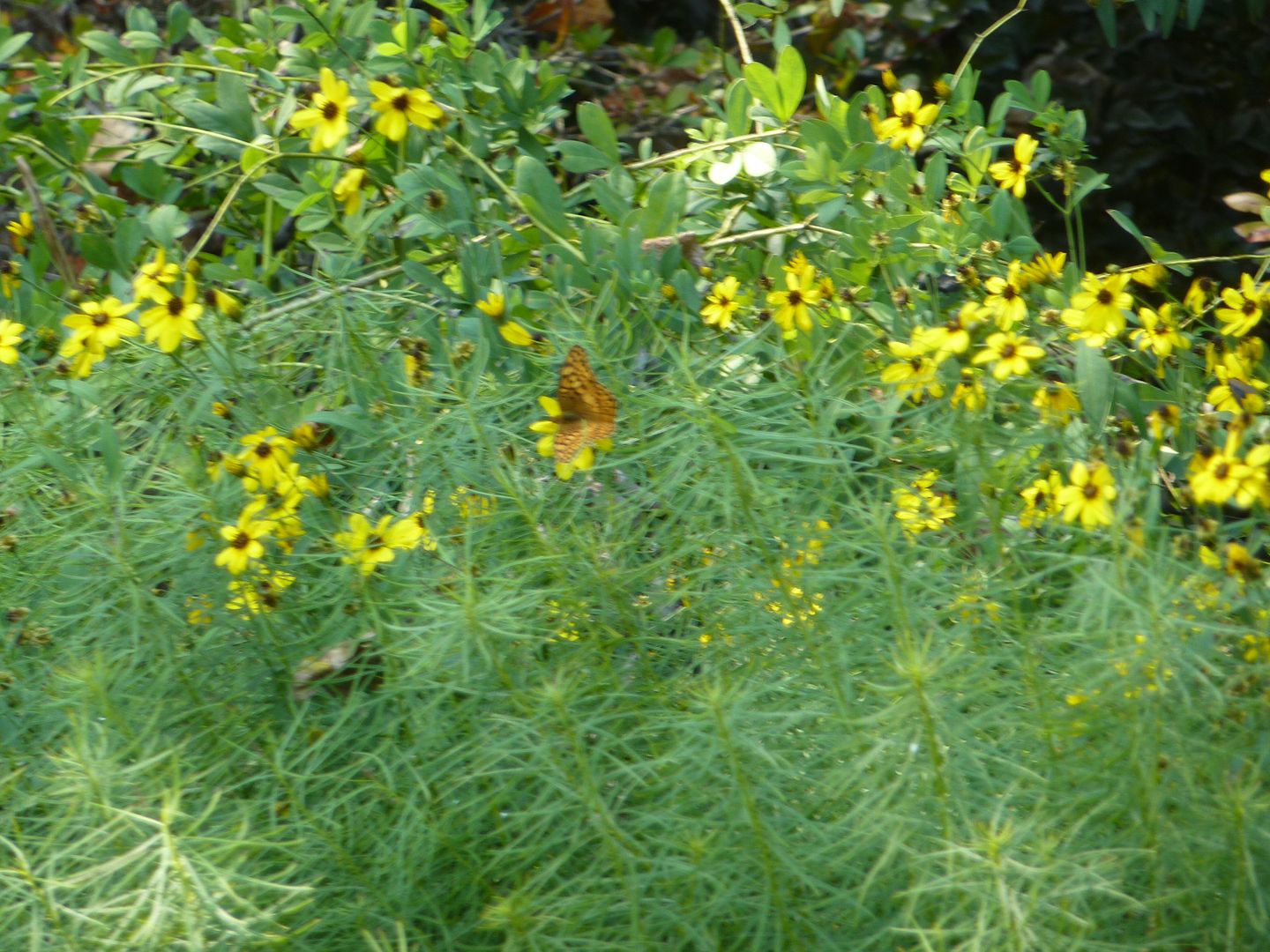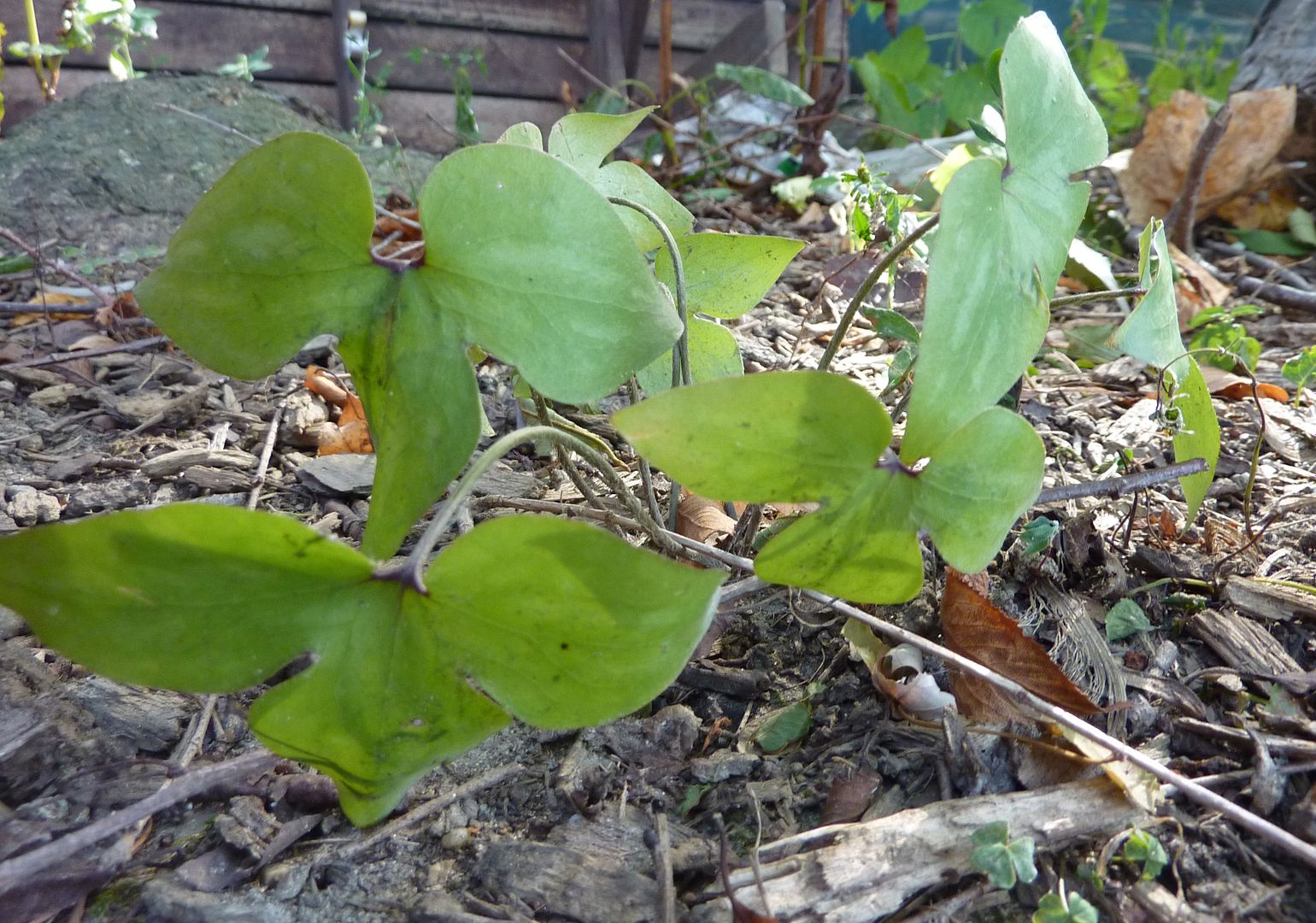Getting back to plants in my yard, I was out and about Saturday taking pictures. Mostly of bees, and out of focus hummingbirds, when I noticed a wonderful swatch of yellow fluttering in.
I think this is an Orange Sulphur. There was a fair amount of black fringe on the inside of the wings. You can sort of make it out here. There is also a brighter patch of yellow on the main wings that is probably orange when viewing them open. If it's not that species than it's likely just a Clouded Sulphur.
I love the green eyes to this group of butterflies. They most use Legumes as a host plant with emphases on the flowers and seed pods. According to BugGuide Alfalfa and Clovers also work.
Monday, September 27, 2010
Sunday, September 26, 2010
Mt. Cuba Center's Autumn Wildflower Palette (Part 3)
This is what put me in awe of the whole tour. It's such a shame my camera didn't capture the fine details.
Things like lighting change depending on how much light I'm standing in, how close, if I'm using a flash and so on. And sadly I don't know enough about photography to do this meadow justice.
This may not have been full of flowers but it's pretty in it's own right. Actually the entire meadow was in bloom it's just most flowering grasses aren't as pretty unless grown in mass to make an effect. Something lost in my photos thus far is how tall the grasses actually are. I believe shorter grasses were planted in front with a hard to make out aster here and there, but towards the back all the grasses were as tall as me. The red brown flourishes of the flower heads are really striking as they blow with the wind and sway in unison.
Something I wish I'd captured better was the soft evergreen to the right in the photo above. There's something about looking through it at the untamed wild beyond that softened the approach. It was like looking through a natural fence.
The meadow there is wonderful and can be viewed through many forest openings.
This Symphyotrichum novae-angliae, New England Aster... a red/pink variety, was quite the eye catcher.
Conoclinium coelestinum, Blue Mist Flower. These lined the forest patch. I have a few in my garden that I planted only just this year. Oddly enough the flower color is off, more red magenta.... which is odd for a plant called blue mist flower.
This is Blue Gentian, I believe the species was Gentiana makinoi but that might be wrong. The flowers are normally a rich royal blue color. These were obviously past their prime but I was taken by the wonderful chocolate color the flowers become. Everyone highlights the blue color of the flowers when selling these because there are so few blue flowering plants and at the end of summer no less that they forget the other attributes as well.
Now we move onto the meadow. The tour guides are the first people to tell you that this is an artificially maintained meadow. Without constant weeding out of tree and other woody species this patch of grass would return to a forest in a matter of years. Normally wildfires and herds of animals like bison, (elephants if you're in Africa), would create and maintain the Savannah-like habitat. Sadly deer aren't that good at what they do.
I really enjoyed seeing all the Solidagos blooming. It was nice for once to have someone around who could tell them all apart. It's such a massive genus.
Solidago speciosa, Showy Goldenrod.
The flowers to this have a little more energy invested in them than other Solidago species. Notice how they actually have little flower petal-like rays circling each flower. The blooms also pull away form the stem and space themselves out a bit more too. Very nice plant.
Solidago rugosa, Wrinkle-Leaf Goldenrod. They had this species on display on purpose. First though notice the long shooting habit the flower stalks have. They all shoot away from the plant much more than most other species and someone came along to cultivate this into...
Solidago rugosa 'Fireworks'
It's called Fireworks because it looks like one. I actually planted one of these this year. Very nice plant. It has almost the habit of forming a bush to it.
I also spied this mantis among the foliage. It was picking off the many insects pollinating the flowers.
Rudbeckia fulgida, Black-Eyed Susan. I was a little surprised to see these blooming. They must have been dead headed or something because the ones I have in my garden are well past flowering and look sort of dead at this time of year. It's always charming to see this plant in mass.
From front to back, Black Eye'd Susan, False Indigo and it's black seed pods, patches of White Bone Set, and assorted grasses such as Big Blue Stem and Yellow Indian Grass.
Physostegia virginiana, Obedient Plant. I was having fun playing with this while the tour guide talked a little about plants. Basically you push the flowers from left to right and they stay there.
I'm toying with the idea of turning the lawn into this.
So that pretty much ends the tour of the Mt. Cuba Center in the late summer fall time. There were so many plants I didn't get around to covering. Many shrubs loaded with berries, plants with serious ornamental appeal at this time of year, and still more flowers I didn't get good pictures of. There were so many asters with butterflies dancing around them too. It feels like such an insult that only 14 people showed up to this class. It only cost $10 and they give you a free plant at the end to take home.
Things like lighting change depending on how much light I'm standing in, how close, if I'm using a flash and so on. And sadly I don't know enough about photography to do this meadow justice.
This may not have been full of flowers but it's pretty in it's own right. Actually the entire meadow was in bloom it's just most flowering grasses aren't as pretty unless grown in mass to make an effect. Something lost in my photos thus far is how tall the grasses actually are. I believe shorter grasses were planted in front with a hard to make out aster here and there, but towards the back all the grasses were as tall as me. The red brown flourishes of the flower heads are really striking as they blow with the wind and sway in unison.
Something I wish I'd captured better was the soft evergreen to the right in the photo above. There's something about looking through it at the untamed wild beyond that softened the approach. It was like looking through a natural fence.
The meadow there is wonderful and can be viewed through many forest openings.
This Symphyotrichum novae-angliae, New England Aster... a red/pink variety, was quite the eye catcher.
Conoclinium coelestinum, Blue Mist Flower. These lined the forest patch. I have a few in my garden that I planted only just this year. Oddly enough the flower color is off, more red magenta.... which is odd for a plant called blue mist flower.
This is Blue Gentian, I believe the species was Gentiana makinoi but that might be wrong. The flowers are normally a rich royal blue color. These were obviously past their prime but I was taken by the wonderful chocolate color the flowers become. Everyone highlights the blue color of the flowers when selling these because there are so few blue flowering plants and at the end of summer no less that they forget the other attributes as well.
Now we move onto the meadow. The tour guides are the first people to tell you that this is an artificially maintained meadow. Without constant weeding out of tree and other woody species this patch of grass would return to a forest in a matter of years. Normally wildfires and herds of animals like bison, (elephants if you're in Africa), would create and maintain the Savannah-like habitat. Sadly deer aren't that good at what they do.
I really enjoyed seeing all the Solidagos blooming. It was nice for once to have someone around who could tell them all apart. It's such a massive genus.
Solidago speciosa, Showy Goldenrod.
The flowers to this have a little more energy invested in them than other Solidago species. Notice how they actually have little flower petal-like rays circling each flower. The blooms also pull away form the stem and space themselves out a bit more too. Very nice plant.
Solidago rugosa, Wrinkle-Leaf Goldenrod. They had this species on display on purpose. First though notice the long shooting habit the flower stalks have. They all shoot away from the plant much more than most other species and someone came along to cultivate this into...
Solidago rugosa 'Fireworks'
It's called Fireworks because it looks like one. I actually planted one of these this year. Very nice plant. It has almost the habit of forming a bush to it.
I also spied this mantis among the foliage. It was picking off the many insects pollinating the flowers.
Rudbeckia fulgida, Black-Eyed Susan. I was a little surprised to see these blooming. They must have been dead headed or something because the ones I have in my garden are well past flowering and look sort of dead at this time of year. It's always charming to see this plant in mass.
From front to back, Black Eye'd Susan, False Indigo and it's black seed pods, patches of White Bone Set, and assorted grasses such as Big Blue Stem and Yellow Indian Grass.
Physostegia virginiana, Obedient Plant. I was having fun playing with this while the tour guide talked a little about plants. Basically you push the flowers from left to right and they stay there.
I'm toying with the idea of turning the lawn into this.
So that pretty much ends the tour of the Mt. Cuba Center in the late summer fall time. There were so many plants I didn't get around to covering. Many shrubs loaded with berries, plants with serious ornamental appeal at this time of year, and still more flowers I didn't get good pictures of. There were so many asters with butterflies dancing around them too. It feels like such an insult that only 14 people showed up to this class. It only cost $10 and they give you a free plant at the end to take home.
Saturday, September 25, 2010
Mt. Cuba Center's Autumn Wildflower Palette (Part 2)
By now I had found enough new plants I'd never herd of or seen in person that I fully felt this was worth the $10 the class cost. Actually the plant they give you at the end was worth that much. Let's continue on.
Chelone lyonii, Pink Turtle Head. Not to be confused with...
Chelone glabra, White Turtle Head. Both of these are marvelous plants. I think of them as a native form of snap dragon however I've come to find they like it wet and can't survive in dry conditions. I don't know if this is right or not but at the Mt. Cuba Center they were mostly in places near the pond, though a few were up hill some, but as you can see with the Pink Turtle Head they were being watered.
Aconitum uncinatum, Wild Monkshood. This isn't the best specimen of this plant they had there. The common names comes from the irregular shape of the flower petals.
Here you can see the hints of blue from the flowers and nearly imposable to make out foliage of the vine itself. This plant dotted all over the gardens as an accent color. Some of the other plants there had blue flowers all over the vine while this one only had them at the tips of new growth. The fuller vines were attractive to butterflies including the Monarch however that photo didn't turn out. This is a plant I'd be interested in trying out.
Another plant they had patches of here and there was Spigelia marilandica, Indian Pink. Supposedly this one is beloved by hummingbirds and when you look at the flower it's easy to see why.
A downside to the plant though is they produce very few flowers. On the upside though when pollination is successful they make exploding seed pods. Those are always fun!
Right up against the pond, (and just about every road side down there!) was Impatiens capensis, Jewelweed!
This is another beloved by hummingbirds. Growing it for the flowers along won't kill you either. This is one I almost bought this year. The thing that held me back though was it's an annual. As with all Impatiens they have exploding seed pods. Seeds take two years to germinate. So patches of this plant will come and go in 3 year rotations.
The other common name to this plant is Touch Me Not because it's related to poison ivy. However, people seem to be touching it nonstop for it's anti poison ivy properties. Apparently the sap to this plant counters that of poison ivy. I don't know if this is true though.
Lobelia siphilitica, Blue Lobelia. This was a nice spot of blue growing by the pond. It's a shame I didn't get any better pictures.
Sanguisorba canadensis, Canadian Burnet. This is one I always hear bees love and yet when I saw it growing there it had no bees on it. Not one. There were quite a few of these clumps of flower stalks too. Not a single bees was on it though. Maybe it has to be a certain time of day or different kind of bee but I just didn't get why it wasn't being loved by bees. I came pretty close to buying this plant and now I'm having second thought.
I'll have part 3 up sometime tomorrow. Let me just say though that standing over the pond there with all the flowers around was the most relaxed I'd felt in a long time. I'm not someone who's stressed out constantly so it's weird that the whole sensation of being relaxed swept over me. I could seriously see a yoga class or something on part with that taking place here.
Chelone lyonii, Pink Turtle Head. Not to be confused with...
Chelone glabra, White Turtle Head. Both of these are marvelous plants. I think of them as a native form of snap dragon however I've come to find they like it wet and can't survive in dry conditions. I don't know if this is right or not but at the Mt. Cuba Center they were mostly in places near the pond, though a few were up hill some, but as you can see with the Pink Turtle Head they were being watered.
Aconitum uncinatum, Wild Monkshood. This isn't the best specimen of this plant they had there. The common names comes from the irregular shape of the flower petals.
Here you can see the hints of blue from the flowers and nearly imposable to make out foliage of the vine itself. This plant dotted all over the gardens as an accent color. Some of the other plants there had blue flowers all over the vine while this one only had them at the tips of new growth. The fuller vines were attractive to butterflies including the Monarch however that photo didn't turn out. This is a plant I'd be interested in trying out.
Another plant they had patches of here and there was Spigelia marilandica, Indian Pink. Supposedly this one is beloved by hummingbirds and when you look at the flower it's easy to see why.
A downside to the plant though is they produce very few flowers. On the upside though when pollination is successful they make exploding seed pods. Those are always fun!
Right up against the pond, (and just about every road side down there!) was Impatiens capensis, Jewelweed!
This is another beloved by hummingbirds. Growing it for the flowers along won't kill you either. This is one I almost bought this year. The thing that held me back though was it's an annual. As with all Impatiens they have exploding seed pods. Seeds take two years to germinate. So patches of this plant will come and go in 3 year rotations.
The other common name to this plant is Touch Me Not because it's related to poison ivy. However, people seem to be touching it nonstop for it's anti poison ivy properties. Apparently the sap to this plant counters that of poison ivy. I don't know if this is true though.
Lobelia siphilitica, Blue Lobelia. This was a nice spot of blue growing by the pond. It's a shame I didn't get any better pictures.
Sanguisorba canadensis, Canadian Burnet. This is one I always hear bees love and yet when I saw it growing there it had no bees on it. Not one. There were quite a few of these clumps of flower stalks too. Not a single bees was on it though. Maybe it has to be a certain time of day or different kind of bee but I just didn't get why it wasn't being loved by bees. I came pretty close to buying this plant and now I'm having second thought.
I'll have part 3 up sometime tomorrow. Let me just say though that standing over the pond there with all the flowers around was the most relaxed I'd felt in a long time. I'm not someone who's stressed out constantly so it's weird that the whole sensation of being relaxed swept over me. I could seriously see a yoga class or something on part with that taking place here.
Friday, September 24, 2010
Mt. Cuba Center's Autumn Wildflower Palette (Part 1)
Yesterday I had the pleasure of attending a course at the Mt. Cuba Center. It was myself, a friend, and 12 other people. After witnessing the sights I saw there I can't help feeling there's something wrong with the world. The cost of admission was $10 and includes a two hour tour of the gardens and a free plant at the end of it. Had I known only 14 people were going to show up I'd have tried a lot harder to get more friends to join me.
Mt. Cuba has a certain stigma in the gardening circle I'm in. Basically everyone agrees that because they're in a woodland setting they have a lot more is blooming in the spring time when the majority of full shade plants bloom. They're right of course but that's no reason to miss out on learning.
Earlier this year I went to the Philadelphia Flower Show (the largest flower show of it's kind in North America!) and I went to Mt. Cuba Center's Spring Wildflower Celebration.
Cost of Admission:
Philadelphia Flower Show - $26 dollars and I felt ripped off.
Mt. Cuba Wildflower Celebration - Free and they hand you a plant for being in the first 500 people... I left there feeling like I must have spent $50 to get in.
Maybe it's just the medium but Mt. Cuba was so much better on so many levels. There's something about walking through an actual garden that carries a single theme of colors and views the whole way through that never fails to be awe inspiring. Where as the Philadelphia Flower show is like walking through a massive garage of broke down parade floats. Flowers are arranged for design ascetic and views. Plants from far off parts of the world are highlighted without any regard or consideration for the environment. I suppose this highlights a difference between non-prophet organizations and landscaping businesses.
My point is having more flowers isn't necessarily better. This was the first time I've been to Mt. Cuba in the late summer/fall time. And I'm happy to say I had just as nice a time as in the spring.
My day began resting on the terrace waiting for the class to begin.
Their pots of carnivorous plants were still out and as carnivorous as ever. I was surprised to see many of them were still blooming, although maybe it's just the fact they're still in pots. I don't know how stressed flowering works in these plants.
The flowers to various pitcher plants feature a safety net to help prevent the pollinator from falling into the pitchers below.
Glancing inside I spied dozens of ants. All of which were alive to my surprise.
Tapinoma sessile, The odorous house ant. I didn't get to stay long enough to see if they were just trapped or somehow treating the pitcher as a food source.
Starting the tour, one of the first plants highlighted was Dicentra eximia, Wild Bleeding-Heart. They go well with ferns but notice how it's still blooming! I'd originally shied away from this species when picking out a bleeding heart for the front garden. I favored one who's flowers looked more heart shaped. Normally these bloom like crazy in the spring but this species will start to bloom again in the fall time.
Collinsonia canadensis, horse balm. This is the big leaf plant in the middle with all the tall spires of small yellow flowers.
I'm not that crazy about the flowers or the plant in particular. But yah know I've always wanted to get my beekeeper friends to plant more natives and have been looking for a shade tolerant nectar source. This could be it. I may give it a try.
Spiranthes odorata, Fragrant Ladies-Tresses. This is a native orchid ... on a very bad day, it's been excessively hot and dry for the whole area. Here is a google image search for what they should look like. The flowers put on quite a show but are a little small for my taste. They are fragrant but I wasn't able to get close enough to them. As for the "Tresses" they don't really look like hair to me and I question the origin of this common name. They might go good next to a pond area where one can sit down and relax.
Eurybia divaricata, White Wood Aster. While we're on the topic of our first aster let me say Asters of North America are now all Asters by common name only. A rather helpful hand out lists all the genera Asters are now put in.
They are:
Symphyotrichum
Ionactis
Eurybia
Seriocarpus
Doellingeria
Ampelaster
and Oclemena.
This white woodland aster is quite common in the area. I know I have several species that reseed all on their own all over my yard. They're easy to grow but don't spread to much to be weedy.
To the left here is the awesome foliage to Amsonia hubrichtii, what they're calling Hubricht's Blue Star. Arkansas Blue Star is another one. In the spring time this plant comes up thinly with lots of blue five pointed flowers. As the summer goes on it turns into this shaggy cloud of wonderful foliage. I just want to lay in it. Very cool plant and there are other Amsonia that are native to more parts of the country but I'm not sure they're as thick and full looking.
This Goldenrod ground cover is Solidago sphacelata, Autumn Goldenrod. For those of you tired of those towering goldenrods that are 5' to 10' tall, this is the ground cover for you. Now that I realize there's this size distance of Solidago's I'm tempted to make a garden of nothing but them.... which is a lot of yellow. This was also the plant everyone who took the class got for free.
This huge plant in the background I thought was a perennial sunflower even after the tour guide kept calling it a Coreopsis. But then I had a closer look and realized oh my god that seriously is Coreopsis that isn't 2' tall.
Coreopsis tripteris, Tall Tickseed. This Goliath of the garden is going on my list for spring of next year! It's huge but the foliage is light and airy as you'd expect from a Coreopsis. Assorted checkerspot butterflies were dancing around it and some ironweed (no photos sorry). The only downside I believe is it might be one of those plants that gets too tall and falls over on everything.
Tomorrow comes part 2 hopefully. There were lots of other plants I didn't get to photograph or did but the images didn't turn out as I'd like.
Mt. Cuba has a certain stigma in the gardening circle I'm in. Basically everyone agrees that because they're in a woodland setting they have a lot more is blooming in the spring time when the majority of full shade plants bloom. They're right of course but that's no reason to miss out on learning.
Earlier this year I went to the Philadelphia Flower Show (the largest flower show of it's kind in North America!) and I went to Mt. Cuba Center's Spring Wildflower Celebration.
Cost of Admission:
Philadelphia Flower Show - $26 dollars and I felt ripped off.
Mt. Cuba Wildflower Celebration - Free and they hand you a plant for being in the first 500 people... I left there feeling like I must have spent $50 to get in.
Maybe it's just the medium but Mt. Cuba was so much better on so many levels. There's something about walking through an actual garden that carries a single theme of colors and views the whole way through that never fails to be awe inspiring. Where as the Philadelphia Flower show is like walking through a massive garage of broke down parade floats. Flowers are arranged for design ascetic and views. Plants from far off parts of the world are highlighted without any regard or consideration for the environment. I suppose this highlights a difference between non-prophet organizations and landscaping businesses.
My point is having more flowers isn't necessarily better. This was the first time I've been to Mt. Cuba in the late summer/fall time. And I'm happy to say I had just as nice a time as in the spring.
My day began resting on the terrace waiting for the class to begin.
Their pots of carnivorous plants were still out and as carnivorous as ever. I was surprised to see many of them were still blooming, although maybe it's just the fact they're still in pots. I don't know how stressed flowering works in these plants.
The flowers to various pitcher plants feature a safety net to help prevent the pollinator from falling into the pitchers below.
Glancing inside I spied dozens of ants. All of which were alive to my surprise.
Tapinoma sessile, The odorous house ant. I didn't get to stay long enough to see if they were just trapped or somehow treating the pitcher as a food source.
Starting the tour, one of the first plants highlighted was Dicentra eximia, Wild Bleeding-Heart. They go well with ferns but notice how it's still blooming! I'd originally shied away from this species when picking out a bleeding heart for the front garden. I favored one who's flowers looked more heart shaped. Normally these bloom like crazy in the spring but this species will start to bloom again in the fall time.
Collinsonia canadensis, horse balm. This is the big leaf plant in the middle with all the tall spires of small yellow flowers.
I'm not that crazy about the flowers or the plant in particular. But yah know I've always wanted to get my beekeeper friends to plant more natives and have been looking for a shade tolerant nectar source. This could be it. I may give it a try.
Spiranthes odorata, Fragrant Ladies-Tresses. This is a native orchid ... on a very bad day, it's been excessively hot and dry for the whole area. Here is a google image search for what they should look like. The flowers put on quite a show but are a little small for my taste. They are fragrant but I wasn't able to get close enough to them. As for the "Tresses" they don't really look like hair to me and I question the origin of this common name. They might go good next to a pond area where one can sit down and relax.
Eurybia divaricata, White Wood Aster. While we're on the topic of our first aster let me say Asters of North America are now all Asters by common name only. A rather helpful hand out lists all the genera Asters are now put in.
They are:
Symphyotrichum
Ionactis
Eurybia
Seriocarpus
Doellingeria
Ampelaster
and Oclemena.
This white woodland aster is quite common in the area. I know I have several species that reseed all on their own all over my yard. They're easy to grow but don't spread to much to be weedy.
To the left here is the awesome foliage to Amsonia hubrichtii, what they're calling Hubricht's Blue Star. Arkansas Blue Star is another one. In the spring time this plant comes up thinly with lots of blue five pointed flowers. As the summer goes on it turns into this shaggy cloud of wonderful foliage. I just want to lay in it. Very cool plant and there are other Amsonia that are native to more parts of the country but I'm not sure they're as thick and full looking.
This Goldenrod ground cover is Solidago sphacelata, Autumn Goldenrod. For those of you tired of those towering goldenrods that are 5' to 10' tall, this is the ground cover for you. Now that I realize there's this size distance of Solidago's I'm tempted to make a garden of nothing but them.... which is a lot of yellow. This was also the plant everyone who took the class got for free.
This huge plant in the background I thought was a perennial sunflower even after the tour guide kept calling it a Coreopsis. But then I had a closer look and realized oh my god that seriously is Coreopsis that isn't 2' tall.
Coreopsis tripteris, Tall Tickseed. This Goliath of the garden is going on my list for spring of next year! It's huge but the foliage is light and airy as you'd expect from a Coreopsis. Assorted checkerspot butterflies were dancing around it and some ironweed (no photos sorry). The only downside I believe is it might be one of those plants that gets too tall and falls over on everything.
Tomorrow comes part 2 hopefully. There were lots of other plants I didn't get to photograph or did but the images didn't turn out as I'd like.
Wednesday, September 22, 2010
Be Back Soon
Coming Soon.
I'll be spending the day in Delaware for a class at the Mt. Cuba Center. It's on fall wildflowers and hopefully I'll have lots of nice pictures and plant ideas. I hear it's better to go in the spring time because they have so many woodland wildflowers and they just come up all over the place. They are located in a forest so we'll see if that's true. They do have a prairie or two on the grounds and they look after an adjacent one I think for meadow studies. So this should be a fun day.
Saturday, September 18, 2010
Hepatica Semi-Evergreen Foliage
A charming benefit to the spring wildflower Hepatica is it's semi-evergreen. So while all those Trilliums, Bloodroot, Bleeding Hearts, Twin leaf, and so on have all died back, Hepatica still keeps it's foliage well into the winter. They are semi-evergreen though, so the leaves do die off by next spring. Semi-evergreen implies that it will still have leaves even after all the deciduous trees have dropped theirs'. So this is a good plant to spread around and possibly use to mark where other wildflowers are planted. Violets could also be used in this way but they can sometimes spread a little aggressively.
Just something to keep in mind what with all the insane deals out there on bulbs now.
Just something to keep in mind what with all the insane deals out there on bulbs now.
Subscribe to:
Posts (Atom)
